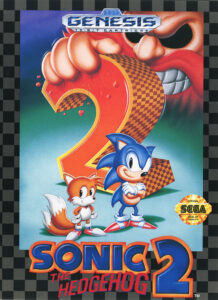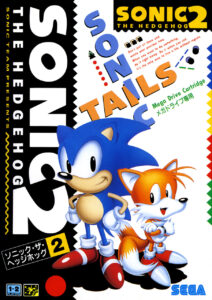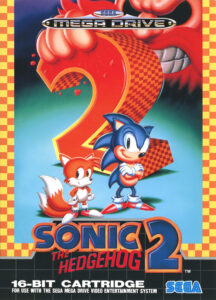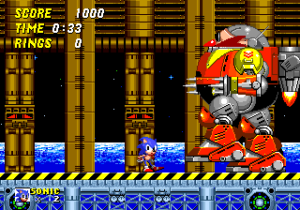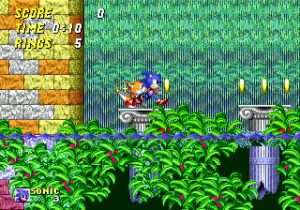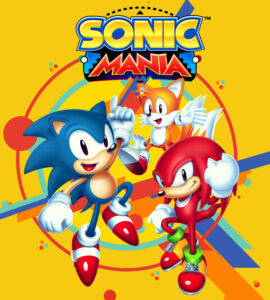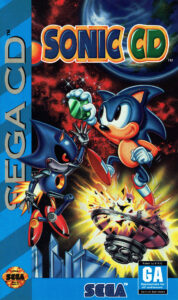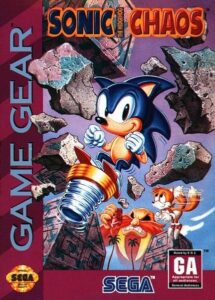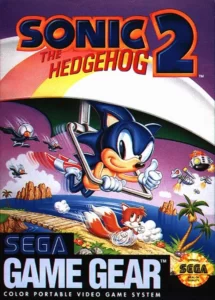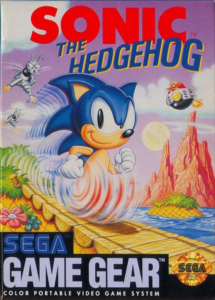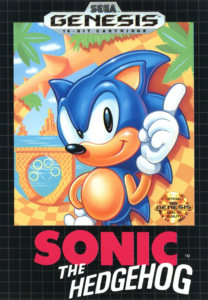in: Games, Main Series
Sonic the Hedgehog 2 (16-bit)
Sonic the Hedgehog 2 (ソニック・ザ・ヘッジホッグ2 Sonikku za Hejjihoggu Tsū) is a platform game within the Sonic the Hedgehog series, developed by a collaboration of Sonic Team Members and Sega Technical Institute. Published by Sega, it was designed for the Sega Genesis/Mega Drive. The game’s release occurred on November 21, 1992, in Japan, followed by its North American and European releases on November 24, 1992. Despite being released in 1993, it serves as the sequel to Sonic the Hedgehog CD and is directly followed by Sonic the Hedgehog 3 in 1994.
In Sonic the Hedgehog 2, the protagonist Sonic, accompanied by his new partner Miles “Tails” Prower, discovers that the nefarious Dr. Robotnik is striving to acquire the Chaos Emeralds situated on West Side Island to power his ominous space station, the Death Egg. With a mission to thwart Robotnik’s ambitions, Sonic and Tails embark on an adventure to defeat his army of Badniks, liberate their animal companions, and race against time to prevent the activation of the dangerous Death Egg. The game contributes to the overarching narrative of the Death Egg saga.
Within six months of its release, Sonic the Hedgehog 2 had sold approximately six million copies, becoming the second-best-selling game for the Mega Drive. It was also notable for its compatibility with the lock-on feature of Sonic & Knuckles, enabling players to experience Knuckles in Sonic 2 as a playable character. The game has been featured in various compilations across different platforms. Subsequently, on June 11, 2007, the game was added to the Wii’s Virtual Console library,[28]Virtual Console Mondays: June 11, 2007. Nintendo World Report. Retrieved on 21 October 2007. followed by releases on the Xbox 360’s Xbox Live Arcade on September 12, 2007,[29]Sonic the Hedgehog 2 on Xbox LIVE Arcade. Xbox. Microsoft. Retrieved on 21 October 2007. and the PlayStation 3’s PlayStation Network on April 19, 2011.
Sonic the Hedgehog 2
Development Staff
Developer(s)
Sega Technical Institute
Publisher(s)
Producer(s)
Shinobu Toyoda
Designer(s)
- Hirokazu Yasuhara (game planner)
- Takahiro Anto (object placement)
- Yutaka Sugano (object placement)
Programmer(s)
- Yuji Naka (chief programmer)
- Bill Willis
- Masanobu Yamamoto
Artist(s)
- Yasushi Yamaguchi
- Craig Stitt
- Brenda Ross
- Jina Ishiwatari
- Tom Payne
- Phenix Rie
- Tim Skelly
- Peter Morawiec
Composer(s)
- Masato Nakamura
Video Game Overview
Series
Sonic the HedgehogRelease date(s)
Sega Mega Drive:
JP 21 November 1992
NA 24 November 1992
EU 24 November 1992
AUS 1 December 1992
Mobile:
JP 2006
Wii Virtual Console:
JP 19 June 2007[1]Virtual Console, page 3. Nintendo. Archived from the original on 6 March 2013.
NA 11 June 2007[2]Sonic the Hedgehog 2. Nintendo. Archived from the original on 23 November 2010.
EU 5 July 2007[3]Sonic the Hedgehog™ 2. Nintendo.
AU July 2007
Xbox Live Arcade:
INT 12 September 2007
BlackBerry:
NA 29 October 2009
iOS:
INT 20 April 2010
INT 12 December 2013 (re-release)
Android:
INT 12 December 2013
PlayStation Network:
INT 19 April 2011
Nintendo Switch:
JP 13 February 2020
INT 20 February 2020
Genre(s)
- Platformer
Mode(s)
Single-player, multiplayer
Rating(s)
ESRB: E
CERO: A
PEGI: 3
ACB: G
USK: 6
Platform(s)
- Sega Mega Drive
- PC
- Wii
- Xbox 360
- PlayStation 3
- Browser
- Nintendo DS
- iOS
- Android
- Nintendo 3DS
- Nintendo Switch
Media
- ROM cartridge
- Digital download
Game Order
| Preceded by | Followed by |
|---|---|
| Sonic the Hedgehog CD | Sonic the Hedgehog 3 |
Plot
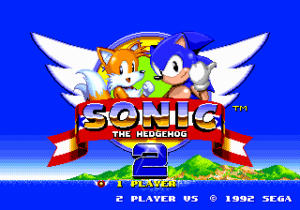
The story of Sonic the Hedgehog 2 is set on West Side Island, a serene and picturesque place with a history shrouded in mystery. Long ago, the island’s inhabitants harnessed enigmatic stones to achieve prosperity, but their misuse led to their downfall, and the stones were sealed away by divine forces deep within the island’s core.[30]Sonic the Hedgehog 2 (Sega Mega Drive) Japanese instruction booklet, pgs. 4-5.
Sonic the Hedgehog, while exploring in his personal aircraft, the Tornado, stumbles upon West Side Island during his travels. Unbeknownst to him, he’s being pursued by a mysterious metallic craft. Upon landing, Sonic’s plane leaves a distinctive trail of exhaust smoke, drawing an elegant white arc. However, his attention is diverted when he spots the enigmatic craft on the other side of the island.
During his time on the island, Sonic encounters a timid orange fox named Miles Prower, nicknamed “Tails” due to his unique twin tails. Tails, inspired by Sonic’s presence, strives to emulate the hedgehog’s coolness and agility. Despite Sonic’s initial indifference, Tails persists in following him, struggling to keep up. Sonic eventually allows Tails to accompany him as he roams the island.
One day, Tails discovers Sonic’s Tornado on the beach and admires it from a distance, careful not to disturb Sonic’s nap beneath its wing. Suddenly, an ominous explosion rocks the nearby forest, followed by a blaze of fire. Robots, under the command of Dr. Robotnik, are wreaking havoc, threatening the island’s tranquility. Tails takes cover under the Tornado to evade the chaos.
Dr. Robotnik, having traced the Chaos Emeralds’ energy signatures to West Side Island, seizes the opportunity to capture the island’s Animals for his Badnik army and locate the Chaos Emeralds, including a legendary seventh one. He aims to complete his powerful space fortress, the Death Egg, for world domination. Sonic and Tails spring into action, vowing to stop Robotnik’s destructive plans.
Throughout their journey, Sonic and Tails liberate various Zones from Robotnik’s control, encountering him numerous times but always prevailing. After freeing the island,[31]Sonic the Hedgehog 4: Episode I. Story. Sega. Archived from the original on 12 May 2013. Retrieved on 27 October 2017. they board the Tornado to reach Robotnik’s Wing Fortress Zone. However, the fortress shoots down the Tornado, separating Sonic and Tails. Sonic continues his quest alone.
Within the Wing Fortress Zone’s control room, Sonic confronts and defeats Robotnik once more. Robotnik escapes in a space rocket just as Tails arrives with a repaired Tornado. Sonic latches onto the space rocket, embarking on a perilous journey into space, ultimately reaching the Death Egg.
Inside the Death Egg, Sonic confronts Mecha Sonic, a robotic duplicate of himself. After a fierce battle, Sonic defeats Mecha Sonic and continues his pursuit of Robotnik. The doctor retreats into his ultimate creation, the Death Egg Robot, in a final attempt to eliminate Sonic. In an intense showdown, Sonic emerges victorious, destroying the Death Egg Robot and triggering a catastrophic explosion that engulfs the Death Egg.
Back on West Side Island, Tails and the rescued Animals watch as the Death Egg explodes, casting a brilliant white light across the sky. Concerned for Sonic’s safety, Tails takes matters into his own hands. He hops into the Tornado and sets off to rescue Sonic from the wreckage of the Death Egg.[32](in Japanese) ソニックジャム オフィシャルガイド. SoftBank. 2 October 1997. p. 53. ISBN 978-4797303377. Meanwhile, Sonic narrowly escapes the collapsing space station, leaving Robotnik behind as he plummets back to the planet’s surface.
The game’s ending varies based on the player’s progress:
- If the player hasn’t collected all seven Chaos Emeralds, Tails catches Sonic on the Tornado as he falls. Together, they pose triumphantly aboard the Tornado with Flickies following them. The scene fades into the credits, concluding with the Sonic the Hedgehog 2 logo.
- If playing as Tails and the player hasn’t collected all seven Chaos Emeralds, the ending is similar, but the sequence where Tails rescues Sonic is skipped, and Sonic pilots the Tornado.
- If the player has collected all seven Chaos Emeralds, Sonic harnesses their power to transform into Super Sonic. Radiating with energy, Super Sonic safely returns to West Side Island. Tails spots him and joins the exhilarating flight, soaring through the sky with the Lockies.
- If playing as Tails and the player has collected all seven Chaos Emeralds, the ending is the same as the above scenario, without the sequence of Tails rescuing Sonic.
Characters
| Image | Character | Biography |
|---|---|---|
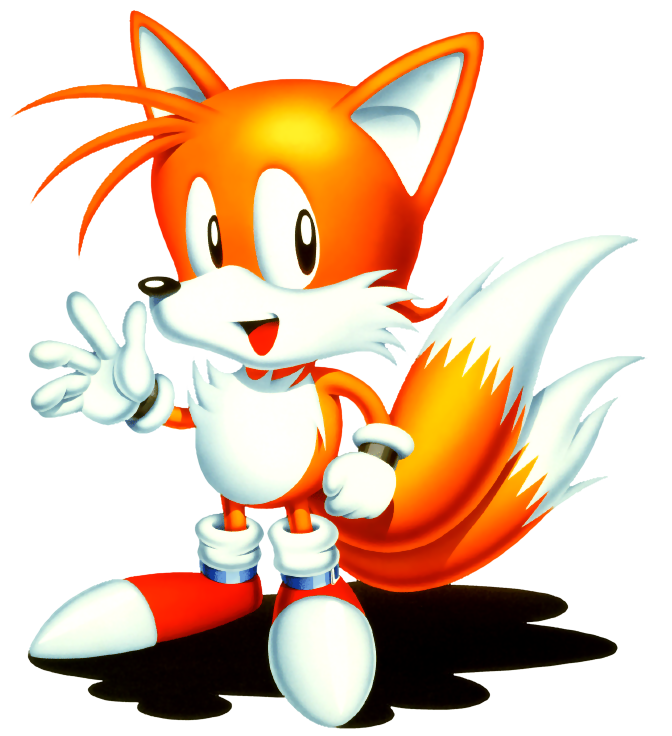 | Miles “Tails” Prower | Because of his two tails, he was bullied by everyone when he was little and was timid, but meeting Sonic and striving to be like him made Miles’s personality bright, energetic and positive.Sonic doesn’t seem to be paying attention to Miles, but he’s actually looking at him sideways.[33]Sonic the Hedgehog 2 (Sega Mega Drive) Japanese instruction booklet, pg. 43. |
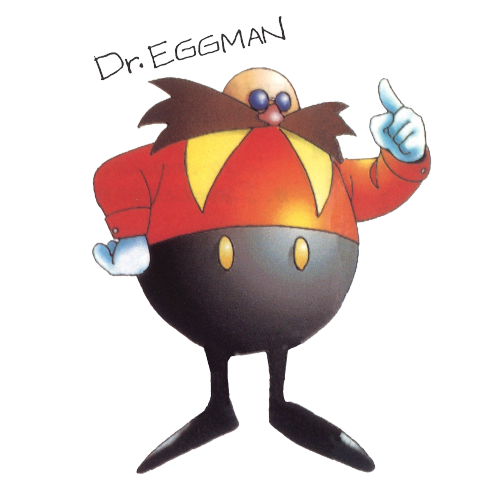 | Doctor Eggman | Evil genius scientist. He wants the Chaos Emeralds. His life’s work is world domination. His rival is Sonic.[34]Sonic the Hedgehog 2 (Sega Mega Drive) Japanese instruction booklet, pgs. 44-45. |
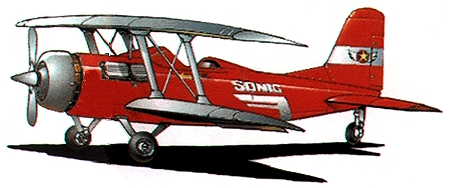 | Tornado | Sonic’s beloved plane, the Tornado. At normal speed, the Tornado can only reach 450km/h, but by installing a custom booster engine tuned by Miles, it can fly past the speed of sound despite being a propeller-driven aircraft. |
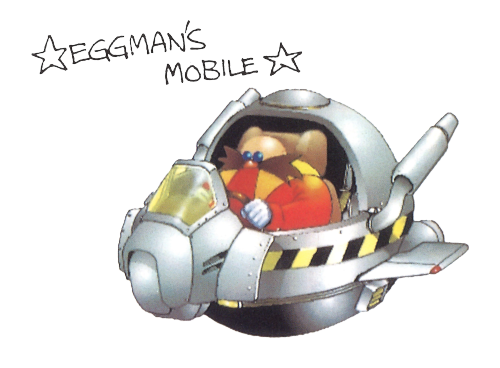 | Eggman’s Mobile | An all-purpose capsule mecha created by Doctor Robotnik. By changing its attachments, it can travel across water, land, air, and even dive underground. He believes that Sonic won’t be a threat to him with this piece of scientific power, but… |
Gameplay
Sonic the Hedgehog 2 continues the iconic side-scrolling 2D platformer gameplay established by its predecessor. Players have the choice to control either Sonic or Tails, or both characters simultaneously. Additionally, a second player can control Tails independently or let the AI control him. Sonic and Tails share the same basic abilities, ensuring a familiar gameplay experience regardless of the character chosen.
The game is divided into eleven Zones, each with two Acts, except for the final Zone. The primary objective is to complete each Act within a time limit of ten minutes. Throughout the Acts, players can collect Rings, which serve as both a form of protection and a method of obtaining extra lives. If a character is hit while holding Rings, they will lose their Rings but remain alive. Losing all Rings results in a life being lost, and running out of lives leads to a Game Over.
The game’s options menu allows players to select different character configurations: Sonic alone, Tails alone, or Sonic and Tails together. When Tails accompanies Sonic, he follows along autonomously. However, a second player can control Tails directly. If Tails goes off-screen or falls, he eventually returns. While playing as Tails, there are minor differences; for example, he cannot fly in this game and is slightly smaller than Sonic.
A notable feature in Sonic the Hedgehog 2 is the introduction of Super Sonic. Collecting all seven Chaos Emeralds by successfully completing the Special Stages grants Sonic the ability to transform into Super Sonic. When Sonic has at least fifty Rings and jumps, he transforms into this powered-up state. Super Sonic is almost invulnerable to damage, except for specific hazards. His speed, acceleration, and jump height are all enhanced. However, his Super Dash Attack is less effective due to rapid deceleration. Super Sonic consumes one Ring per second, and when he runs out of Rings or completes an Act, he reverts to his normal form.
Scoring System
- Every 50,000 points: 1-Up.
- Hitting Badniks/breakable blocks
- First hit: 100 points.
- Second hit: 200 points.
- Third hit: 500 points.
- Fourth through fifteenth hit: 1,000 points each.
- Sixteenth hit and above: 10,000 points each.
- Bumpers: 10 points constantly until the tenth hit.
- Drop Targets: 10 points constantly until the third hit.
- Slots: Eight sets of 10 points.
- Defeating Dr. Eggman: 1,000 points.
Special Stages
- Ring Bonus: 100 points per Ring for each playable character.
- Chaos Emerald: 10,000 points.
End-of-Zone tally
- Ring Bonus: 100 points per Ring.
- Time Bonus
- < 0:29: 50,000 points.
- 0:30 – 0:44: 10,000 points.
- 0:45 – 0:59: 5,000 points.
- 1:00 – 1:29: 4,000 points.
- 1:30 – 1:59: 3,000 points.
- 2:00 – 2:59: 2,000 points.
- 3:00 – 3:59: 1,000 points.
- 4:00 – 4:59: 500 points.
- > 5:00: 0 points.
- Perfect Bonus: 50,000 points after collecting every Ring.
- 10,000 points or more at the end of an Act: Continue.
Controls
| Button Formation | |
|---|---|
| Run | |
| Look up | |
| Look down/Crouch | |
| Spin jump | |
| Super Spin Attack | |
| Super Dash Attack | |
| START | Pause |
Objects
Items
- Air Bubble
- Chaos Emerald
- Monitor
- Eggman Mark
- Invincible
- One-Up
- Power Sneakers
- Random
- Shield
- Super Rings
- Teleporter
- Ring
- Star Circle
Gimmicks and Obstacles
- Arrow column (first appearance)
- Blue blob (first appearance)
- Bomb
- Breakaway column (first appearance)
- Booster (first appearance)
- Bumper
- Bumper wall (first appearance)
- Cannon (first appearance)
- Conveyor Belt
- Crusher
- Drop Target (first appearance)
- Elevator
- Fan
- Flipper
- Giant spear
- Goal Plate
- Gondola (first appearance)
- High-speed warp tube (first appearance)
- Hexagonal bumper
- Iron ball
- Jump Panel (first appearance)
- Mega Mack (first appearance)
- Metal nut (first appearance)
- Prison Egg
- Seesaw
- Sinking pool (first appearance)
- Slot machine (first appearance)
- Spikes
- Spring
- Spring Catapult (first appearance)
- Star Post
- Switch
- Triangle Bumper (first appearance)
Characters
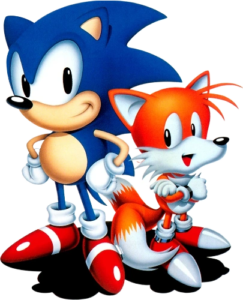
Playable characters
- Miles “Tails” Prower
- Sonic the Hedgehog
- Super Sonic (first appearance)
Non-playable characters
- Dr. Robotnik
- Animals
- Becky (first appearance)
- Cucky
- Flicky
- Locky (first appearance)
- Micky (first appearance)
- Pecky
- Pocky
- Ricky
- Rocky
- Wocky (first appearance)
- Tocky (first appearance)
Enemies
- Asteron (first appearance)
- Aquis (first appearance)
- Balkiry (first appearance)
- Buzzer (first appearance)
- Chop Chop (first appearance)
- Clucker (first appearance)
- Coconuts (first appearance)
- Crawl (first appearance)
- Crawlton (first appearance)
- Flasher (first appearance)
- Grabber (first appearance)
- Grounder (first appearance)
- Masher (first appearance)
- Nebula (first appearance)
- Octus (first appearance)
- Rexon (first appearance)
- Shellcracker (first appearance)
- Slicer (first appearance)
- Sol (first appearance)
- Spiker (first appearance)
- Spiny (first appearance)
- Turtloids (first appearance)
- Whisp (first appearance)
Zones
- Emerald Hill Zone
- Chemical Plant Zone
- Aquatic Ruin Zone
- Casino Night Zone
- Hill Top Zone
- Mystic Cave Zone
- Oil Ocean Zone
- Metropolis Zone
- Sky Chase Zone
- Wing Fortress Zone
- Death Egg Zone
Special Stages
Main article: Special Stage (Sonic the Hedgehog 2)
Sonic the Hedgehog 2 includes seven unique Special Stages. To access these stages, players must gather a minimum of fifty Rings and then interact with a Star Post. This action prompts a fleeting red halo of stars to appear above the Star Post, which serves as an entry point to the Special Stage.
In these Special Stages, the player’s perspective follows behind as they navigate a three-dimensional half-pipe track. This track is populated with both Rings and Bombs. The primary goal is to amass a specific quantity of Rings in order to pass through three distinct checkpoints and ultimately earn a Chaos Emerald. If players are engaged in cooperative play with Tails, certain Ring targets are adjusted in the early Special Stages to accommodate both characters. The sequence of these stages is predetermined, gradually increasing in difficulty. Progression to the next stage necessitates clearing the preceding one. Regardless of whether or not the player secures the Chaos Emerald, completing a Special Stage returns Sonic to the last activated Star Post within the Zone.
Upon reentry from a Special Stage, the entire Zone undergoes a reset, excluding the game timer. While collected Rings are forfeited, previously obtained monitors, Rings, and enemies are reinstated. Moreover, if Sonic triggers a Star Post, all prior Star Posts are activated, regardless of whether fifty Rings are in possession or not. This strategic feature introduces a tactical aspect to optimizing Zone exploration, providing opportunities to attain Emeralds. Notably, it is feasible to gather all seven Chaos Emeralds within the confines of the Emerald Hill Zone.
Bosses
- Egg Drillster (Emerald Hill Zone) (first appearance)
- Egg Poison (Chemical Plant Zone) (first appearance)
- Egg Hammer (Aquatic Ruin Zone) (first appearance)
- Egg Claw (Casino Night Zone) (first appearance)
- Egg Scorcher Mk. II (Hill Top Zone) (first appearance)
- Egg Digger (Mystic Cave Zone) (first appearance)
- Eggmarine (Oil Ocean Zone) (first appearance)
- Egg Bouncer (Metropolis Zone) (first appearance)
- Laser Prison (Wing Fortress Zone) (first appearance)
- Mecha Sonic (Death Egg Zone) (first appearance)
- Death Egg Robot (Death Egg Zone) (first appearance)
Other Modes
2 Player VS
In the 2 Player VS mode of Sonic the Hedgehog 2, two players engage in a competitive showdown. They can choose to play as either Sonic or Tails and race against each other in split-screen format. This mode comprises three regular zones – Emerald Hill, Casino Night, and Mystic Cave – along with a shared Special Stage. Notably, the regular zones feature distinct music compared to their single-player counterparts, while the Special Stage remains consistent with the single-player version.
Throughout the regular levels, players receive rankings in five different categories: score, time taken, rings held at the level’s conclusion, total rings collected, and the number of item boxes shattered. The player with the highest score across these categories wins the round. Within the Special Stage, the competition revolves around accumulating the most rings.
A time constraint adds intensity to the gameplay. Once one player completes a regular level, the other player must also finish the zone within 60 seconds to avoid losing a life.
In the event of a tie, an extra round involving another Special Stage is required to determine the victor. The competitive aspect is further enriched by two unique items: a Teleporter item that swiftly swaps positions between the players within a zone, and an Eggman item that inflicts damage on the less fortunate player. Additionally, players have the option to activate a setting that restricts all item boxes in two-player mode to Teleporters only.
Development
Background
The original Sonic the Hedgehog, developed by Sonic Team in Japan, was released worldwide in 1991 and significantly boosted Sega’s popularity, making the company a strong competitor to Nintendo, which had dominated the video game market. However, prior to the game’s release, programmer Yuji Naka left Sega of Japan due to dissatisfaction and financial issues with the company.[36]Horowitz, Ken . Developer’s Den: Sega Technical Institute. Sega-16. Archived from the original on 16 August 2011. Retrieved on 27 March 2023.[37]Maba, Ray (24 June 2016). 『ソニック・ザ・ヘッジホッグ』誕生・ヒット・新生の真実をソニックチームのレジェンドクリエイターが、25周年のいま明かす 秘蔵資料満載の永久保存版! (Japanese). Famitsu. Retrieved on 27 March 2023.[38]Maba, Ray (24 June 2016). 『ソニック・ザ・ヘッジホッグ』誕生・ヒット・新生の真実をソニックチームのレジェンドクリエイターが、25周年のいま明かす 秘蔵資料満載の永久保存版! (Japanese). Famitsu. Retrieved on 27 March 2023.
During Sonic the Hedgehog’s development, American game designer Mark Cerny, who had previously worked on Sega games like Galactic Protector, established the Sega Technical Institute (STI) in the United States. The aim was to hire promising American game designers who would receive training from experienced minds at Sega of Japan. Hirokazu Yasuhara, the game designer of Sonic the Hedgehog, was among the first to be offered a position on the team. He accepted a year later after making up his mind. Cerny learned about Naka’s situation during a visit to Japan and convinced him to rejoin Sega at STI, offering him better conditions and shielding him from Sega of Japan’s criticism. Other members of Sonic Team also joined the new institute.[39]strafefox (22 May 2018). The Making of Sonic the Hedgehog 2. YouTube. Retrieved on 20 April 2023. Meanwhile, the remaining development team stayed in Japan to work on Sonic the Hedgehog CD, as requested by Sega’s president.
In September 1991, Naka moved to California and reunited with Yasuhara. Cerny, who had other original projects in progress, proposed a sequel to Sonic the Hedgehog, but Sega’s management initially thought it was too soon for one. While the team worked on various experiments for a potential sequel, the situation changed in November when Cerny received a sudden call from his superiors indicating that they needed the game. The release date was initially set for October 1992, giving the team only eleven months to complete the game.
Facing the pressure of a shortened timeline, Cerny had to quickly organize his team to meet the deadline. Full-scale development of Sonic the Hedgehog 2 began in early 1992. Initially, the development team consisted exclusively of Americans, as the Japanese members had not yet arrived due to visa complications.
Design
According to Al Nilsen, the former marketing director of Sega of America, the Sega Technical Institute (STI) was determined to go all out with Sonic the Hedgehog 2 and ensure its success, especially since sequels were often viewed less favorably.[40]Shea, Brian (21 November 2017). The Behind-The-Scenes Story Of How Sonic 2 Became Sega’s Ace In The Hole. Game Informer. Retrieved on 27 March 2023. Despite having a small team of only ten people, they aimed to build upon the achievements of the original game.
The team at STI brainstormed various new ideas to enhance the gameplay experience. One significant innovation was the decision to make Sonic even faster than before, pushing the boundaries of his speed compared to the first game. To facilitate this, they introduced a new move known as the “Spin Dash,” which allowed players to rapidly reach high speeds without feeling overwhelmed.[41]Video Archive (22 April 2022). Sonic Panic (Sonic 2 Promo Video) [ENGLISH CC] {Windii Reupload}. YouTube. Retrieved on 27 March 2023.
During the development process, an early version of Sonic the Hedgehog 2 included a feature where Sonic would take damage if he collided with a wall at high speed. However, this concept was later discarded in subsequent builds of the game. The focus remained on refining the gameplay mechanics and ensuring that the sequel delivered an even more exhilarating and enjoyable experience for players.
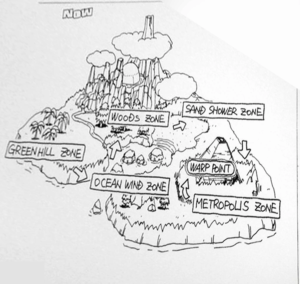
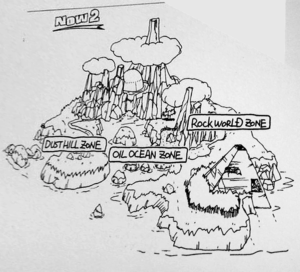
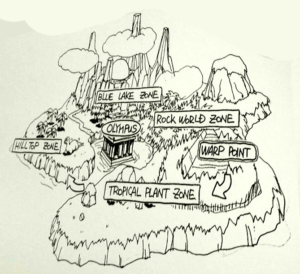
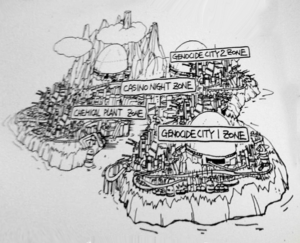
During the same period, Hirokazu Yasuhara, the game designer, was actively developing his own plans and ideas for Sonic the Hedgehog 2. He envisioned a storyline and gameplay mechanics that diverged significantly from the final product. Yasuhara’s initial concept centered around a time travel-based narrative. In this version, Dr. Robotnik would manipulate time to alter Earth’s history, prompting Sonic to embark on a journey through time to thwart Robotnik’s plans and prevent the rise of a Robotnik Empire.
Yasuhara’s vision involved the exploration of multiple timelines, including the present, the past, an alternate present shaped by Robotnik’s interference, and a dystopian future ruled by the villain. Each timeline would offer distinct challenges and environments. However, as development progressed, the team recognized that these ambitious ideas would be challenging to fully realize within the game’s tight release schedule. As a result, they decided to shift towards a more streamlined design reminiscent of the first game.
Despite the change in direction, certain elements of Yasuhara’s original concept found their way into the final game. Several Zones that were initially conceived within the context of different timelines were integrated into Sonic the Hedgehog 2’s gameplay. For instance, Hill Top Zone was originally envisioned as the past version of Green Hill Zone, while Oil Ocean Zone was linked to the modified present. Additionally, Chemical Plant Zone and Casino Night Zone emerged from the future timeline dominated by Dr. Robotnik’s rule. Notably, a similar time travel concept was later employed in Sonic the Hedgehog CD, which was released in 1993 and explored the theme of time manipulation in a different context.
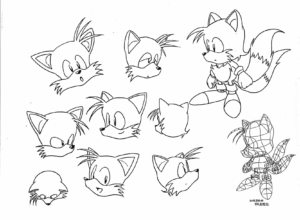
Initially, Sonic the Hedgehog was intended to feature a multiplayer mode, although this idea didn’t make it into the final version of the game. Yuji Naka, the game’s programmer, devised a creative solution for incorporating split-screen multiplayer gameplay. He designed two complete game screens stacked on top of each other and compressed them to fit within the 4:3 aspect ratio of televisions. This innovation aimed to allow siblings and players to engage in cooperative gameplay, enhancing the overall enjoyment of the game.
Naka sought to introduce a second playable character who would be cute and endearing, drawing inspiration from Kitsune in the anime series “Urusei Yatsura.”[42]Judy Totoya on Twitter. Twitter (21 November 2022). Retrieved on 21 November 2022. This character would hold a deep admiration for Sonic.[43]Sonic’s Creator – Yuji Naka. Archived from the original on 5 June 1997. Retrieved on 28 August 2008. To select this character, a contest was held at Sega Technical Institute (STI). The winning entry, submitted by Yasushi Yamaguchi, the main artist and level designer for Sonic Team, introduced a character named “Miles Power,” a playful reference to speed measurements in miles per hour. However, the name “Power” was later modified to “Prower” to avoid an overly powerful connotation.
Further changes to the character’s name were suggested during discussions. Al Nilsen, the marketing director, and Madeline Schroeder, the product manager, advocated for changing the name from “Miles” to “Tails,” a suggestion that Yamaguchi found disappointing.[44]Al Nilsen on Twitter. Twitter (29 December 2021). Archived from the original on 29 December 2021. Retrieved on 29 December 2021.. After deliberation, a compromise was reached: the full name “Miles Prower” would serve as the character’s legal name, while “Tails” would function as his nickname. This resulted in the character being known as Miles “Tails” Prower.
While “Tails” emerged as the chosen character, other proposed characters, such as “Boomer the Turtle,” did not ultimately make it into the game’s final design. The introduction of “Tails” as Sonic’s sidekick and the creative process surrounding his character name became a significant aspect of Sonic the Hedgehog’s development history.
Conflicts
The development of Sonic the Hedgehog 2 encountered challenges stemming from cultural disparities between the Japanese and American development teams. Despite maintaining friendly relations, significant differences in working styles emerged. The Japanese developers were seasoned professionals within Sega’s ranks, which posed difficulties for the relatively less experienced American team members to match their pace. This discrepancy in experience and expertise led to disparities in performance.
Moreover, the two groups exhibited distinct work ethics and practices. Many team members from both sides adopted unconventional working patterns, including overnight shifts and even sleeping in their office cubicles. Tim Skelly, a former member of Sega Technical Institute (STI), noted that Yuji Naka, the Japanese programmer, might have found greater comfort in an all-Japanese team, given the contrasting work dynamics.
Compounding these challenges was the expansive scope of the project and the unique work environment in the United States. The small size of the team necessitated that they undertake all aspects of the project themselves, further intensifying the workload. These cultural differences and logistical complexities added layers of intricacy to the development process of Sonic the Hedgehog 2.
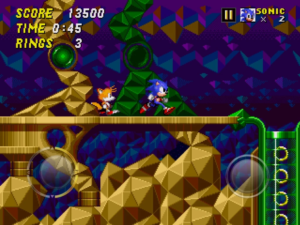
Due to memory limitations, a significant amount of content had to be removed from Sonic the Hedgehog 2 during its development. Al Nilsen commented on this, suggesting that the game could have been much larger in scope if all the original content had been retained. The development team, led by Naka, had a willingness to discard elements that weren’t working effectively, even if they had already invested significant time into them.
One notable example of discarded content is the “Hidden Palace Zone,” which was initially planned to feature two Acts where Sonic could transform into Super Sonic after collecting all the Chaos Emeralds. This concept was later altered to a single Act, and ultimately abandoned entirely in favor of allowing players to access Super Sonic in any Zone.[45]Sega’s Yuji Naka Talks!. GameSpy. Retrieved on 3 January 2015. “GameSpy: Was the Hidden Palace meant to be “hidden,” then? / Yuji Naka: You’d encounter the stage through normal play by collecting the emeralds. The idea behind the stage was, ‘Where do the Chaos Emeralds come from?’ That’s where Sonic was originally supposed to be granted his Super Sonic powers. We finally were able to use it in S&K, though it wound up being quite different from what we had planned in Sonic 2. But even from Sonic 1 we’d been throwing around those sorts of ideas. Still, when we were running out of time, we looked over things quickly trying to figure out what to dump … and CHOP went the Hidden Palace. There’s simply no way we could have thrown that in by the deadline at the rate we were going.”[46]Craig Stitt Interview. Sonic Research Zone (23 January 2001). Retrieved on 25 January 2015. Other well-known zones that were scrapped include “Wood Zone,” “Sand Shower Zone,” and “Cyber City Zone.” Naka remembered that as many as five stages were removed, with one being fully completed before being cut just days before the game’s release due to memory constraints.[47]“The People Making Sega’s Future“. Beep! Mega Drive (SoftBank): 46–48. January 1993. Archived from the original on 29 December 2021.. “Yuji Naka: There’s still so much I want to add. For Sonic 2, we had to remove so much due to memory limitations. We actually made about five more zones, but in the end, we had to cut them all. We actually cut one zone at the absolute very last minute. Even though it was basically complete, we couldn’t use it because of a lack of memory. There just wasn’t enough space.”
The development process was intense, with the team refining the game up until the very last moment. To ensure a successful release, the finished game was transported to Japan by two separate individuals on different planes to mitigate the risk of any issues arising during transportation. This highlights the high stakes and dedication that went into the creation of Sonic the Hedgehog 2.
Promotional
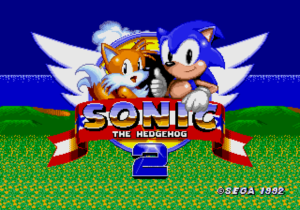
The marketing campaign for Sonic the Hedgehog 2 was robust and aggressive, commencing in early 1992. Recognizing the popularity of the video game-themed TV show Nick Arcade on Nickelodeon, Sega capitalized on the opportunity to promote the upcoming game. They sent an early copy of Sonic the Hedgehog 2 to Nick Arcade for showcase purposes. However, during a special episode featuring actors from the show Clarissa Explains It All, Melissa Joan Hart and Jason Zimbler struggled to play the game due to their unfamiliarity with the newly introduced Spin Dash move.[48]Kemps, Heidi (15 July 2020). 7 Sonic The Hedgehog Prototypes You Were Never Meant To Play. Kotaku. Retrieved on 19 April 2023.
Being Sega’s flagship game for 1992, the marketing team aimed to turn the game’s release into a celebration rather than just a product launch. Sega was confident in the game’s potential success and invested heavily in its promotion. In Japan, a promotional VHS titled “Sonic Panic” was released to generate excitement. This video depicted Sonic and Tails triumphing over Mario and Luigi, symbolizing the fierce competition between Sega and Nintendo at the time. The video provided insights into the game’s development and new features, with Yuji Naka sharing details.
Tails, the new playable character, was prominently featured in teasers and promotional materials. The game’s tagline, “Are you up 2 it?”, was displayed on posters to engage potential players. The game’s box art differed between regions. The international version, illustrated by Greg Martin, showcased Sonic and Tails in front of a large number “2,” with Dr. Robotnik looming above. In contrast, the Japanese artwork, crafted by Akira Watanabe, maintained a consistent visual style seen in many of Sega’s key titles of that era.[49]Ayden_ (3 April 2022). L’histoire des boitiers et jaquettes du jeu vidéo : Artistes, mystères et anecdotes (French). Jeuxvideo.com. Retrieved on 19 April 2023.
Release
Sonic the Hedgehog 2 made its initial debut on November 21, 1992, in Japan. In the Western regions, Sega of America initially intended to conduct a promotional tour of shopping malls throughout the United States for the game’s release. However, this plan was ultimately reconsidered as not aligning well with Sega’s brand identity. Instead, a more ambitious approach was adopted: a high-profile, simultaneous global release. This departure from the norm of staggered regional release dates was quite uncommon for that era. Consequently, Sonic the Hedgehog 2 was launched internationally on Tuesday, November 24, 1992, a date playfully referred to as “Sonic 2sday” in promotional materials.[50]Bryant, Martin (25 July 2015). Sonic 2 and making a real impact with your marketing. The Next Web. Retrieved on 19 April 2023.[51]Sonic the Hedgehog (24 November 2022). Sonic the Hedgehog on Twitter. Twitter. Retrieved on 19 April 2023. “It’s been 30 years since Sonic 2sday and the release of Sonic the Hedgehog 2. Life wouldn’t be the same without you, little buddy!”
Reception
Sales
Building on the strong foundation established by its predecessor, Sonic the Hedgehog 2 benefited from an existing fanbase eagerly anticipating its launch.[52]Lucas M., Thomas (2007). IGN’s Sonic the Hedgehog 2 Review. IGN. Ziff Davis. Retrieved on 21 October 2007. When it was finally released, the game garnered widespread critical acclaim. Its success was reflected in the charts, as it claimed the top spot in the UK charts for a remarkable two months.[53]“Official Gallup UK Mega Drive Sales Chart”. Mega (6). March 1993. Notably, it also secured the title of the highest-selling game of 1992.[54]Shea, Brian (July 20 2022). Sonic Frontiers Cover Story – Brave New World. Game Informer. Retrieved on 23 July 2022.
In terms of sales figures, Sonic the Hedgehog 2 proved to be a remarkable success. By 2006, the game had amassed an impressive total of over 6 million copies sold worldwide.[55]Boutros, Daniel (4 August 2006). A Detailed Cross-Examination of Yesterday and Today’s Best-Selling Platform Games. Gamasutra. Retrieved on 8 December 2006. This sales achievement positioned it as the second best-selling game for the Sega Mega Drive, a notable accomplishment considering the popularity of the original Sonic the Hedgehog. It’s worth noting that within this global sales figure, only 400,000 cartridges were sold in Japan,[56]Kai, Norton (April 1993). “Sonic CD Slips Up“. Sega Force (16): 12. Archived from the original. Retrieved on 28 February 2022. indicating the game’s particularly strong appeal in other regions.
Critical Reception
Sonic the Hedgehog 2 received widespread critical acclaim. Early 1990s magazine reviews resulted in a combined score of 93% at Defunct Games based on 10 reviews. In the 2000s, retrospective online reviews yielded an average score of 88.44% at GameRankings, derived from 8 reviews.
Reviewers praised various aspects of the game, including its expansive levels, vibrant graphics,[57]“Game Zero’s Sonic the Hedgehog 2 Review“. Game Zero. 1993. Archived from the original. increased characters and enemies, and engaging music. Upon its release, Ed Simrad of Electronic Gaming Monthly highlighted the game’s extended playtime, emphasizing the enhanced enjoyment and innovative new moves. GamePro acknowledged the challenge of following a classic but noted the sheer fun of Sonic the Hedgehog 2, declaring it a fantastic gaming experience. Game Informer’s Andy appreciated the game’s increased difficulty and variety, along with the addition of the two-player split screen mode. Jaz of Mean Machines Sega described the game as faster, more colorful, and significantly tougher than its predecessor, commending its abundance of features and secrets.
In retrospective reviews, GameSpot remarked that time had not diminished the game’s appeal, emphasizing its enduring sweetness and enjoyable gameplay. Critics also praised the game’s faster pacing compared to the first installment, as well as its innovative features. Lucas M. Thomas of IGN specifically commended the Spin Dash ability for enhancing Sonic’s speed[58]Thomas, Lucas M. (26 January 2007). Sonic the Hedgehog VC Review. IGN. Retrieved on 18 November 2014. and noted the game’s emphasis on platform running rather than jumping.
However, the game’s competitive split-screen two-player mode, a novel addition to the series, faced criticisms.[59]Dotson, Carter . Sonic the Hedgehog 2 Gets the Remastering Treatment, With the Long-Lost Hidden Palace Level Restored. 148Apps. Retrieved on 18 November 2014. While generally well-received at launch, reviewers noted drawbacks such as noticeable slowdown, flickering, and restricted screen space for each player. IGN, on the other hand, praised the innovative two-player mode, highlighting its unique competitive aspect.[60]Thomas, Lucas M. (11 June 2007). Sonic the Hedgehog 2 Review. IGN. Retrieved on 18 November 2014. William Burrill of the Toronto Star critiqued the two-player racing mode, describing it as the game’s only fault due to graphics compression and reduced action speed caused by the split screen view.[61]Burrill, William (12 December 1992). “This Sonic is super, too”. Toronto Star: F4.
Awards
Sonic the Hedgehog 2 received several prestigious awards and has been consistently recognized as one of the greatest video games of all time. Electronic Gaming Monthly bestowed upon it the title of Best Game of the Year for the Sega Mega Drive, praising its excellence and asserting it to be the best Genesis cartridge in a long time. Game Informer awarded Sonic the Hedgehog 2 the accolade of Best Action/Adventure Game, commending its ability to retain the original game’s essence while introducing enhancements such as a two-player mode, extended levels, new abilities, and improved animation.
The game’s acclaim extends beyond individual awards. It has earned its place among the greatest video games in history. Game Informer ranked Sonic the Hedgehog 2 at number 61 on their “Top 100 Games of All Time” list in 2000, lauding its challenging gameplay and polished design.[62]“Top 100 Games of All Time”. Game Informer (100): 28. August 2001. Subsequently, it secured the 97th spot on the same list in 2009.[63]Game Informer’s Top 200 Games of All Time. Game Informer (2009). Mega magazine included Sonic the Hedgehog 2 at the 36th position in their “Top Sega Mega Drive Games of All Time” list published in 1994.[64]Mega (Future Publishing) (26): 74. November 1994. The game has also been featured in prominent rankings by Electronic Gaming Monthly,[65]EGM Top 100. Electronic Gaming Monthly (November 1997). Retrieved on 1 June 2011. GameFAQs,[66]Spring 2004: Best. Game. Ever.. Retrieved on 16 July 2008. GamingBolt,[67]Top 100 greatest video games ever made. GamingBolt (2013). Guinness World Records,[68]Guinness World Records 2009 Gamer’s Edition reveals the Top 50 console games of all time. Guinness World Records Gamer’s Edition (2009). NowGamer,[69]NowGamer (Imagine Publishing). 2010. part 1, part 2, part 3, part 4 Retro Gamer,[70]Retro Gamer (1): 30. January 2004. Yahoo!,[71]The 100 greatest computer games of all time. Yahoo! (2006). IGN,[72]IGN Staff (15 July 2022). The 10 Best Sonic Games. IGN. Retrieved on 2 December 2022. and WatchMojo,[73]Reynolds, J. (2022) Top 20 Best Sonic The Hedgehog Games, WatchMojo. Available at: https://watchmojo.com/video/id/48699 (Accessed: December 19, 2022). underlining its enduring legacy and impact on the gaming industry.
Re-Releases
| Image | Game | Platform | Description |
|---|---|---|---|
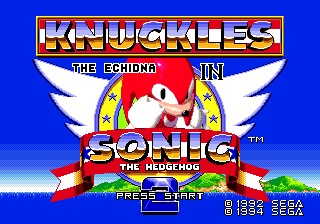 | Knuckles in Sonic 2 | Sega Mega Drive | The result of locking Sonic the Hedgehog 2 on to Sonic & Knuckles. |
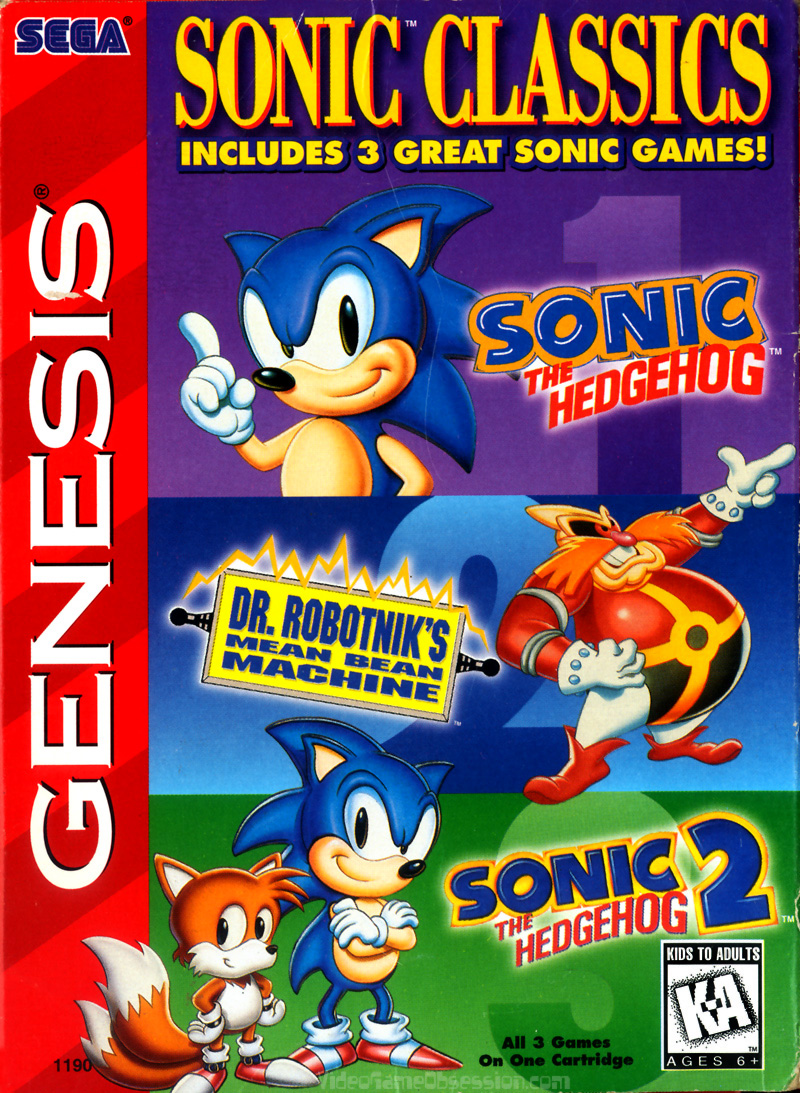 | Sonic Compilation | Released as a bundle with Sonic the Hedgehog and Dr. Robotnik’s Mean Bean Machine in 1995. | |
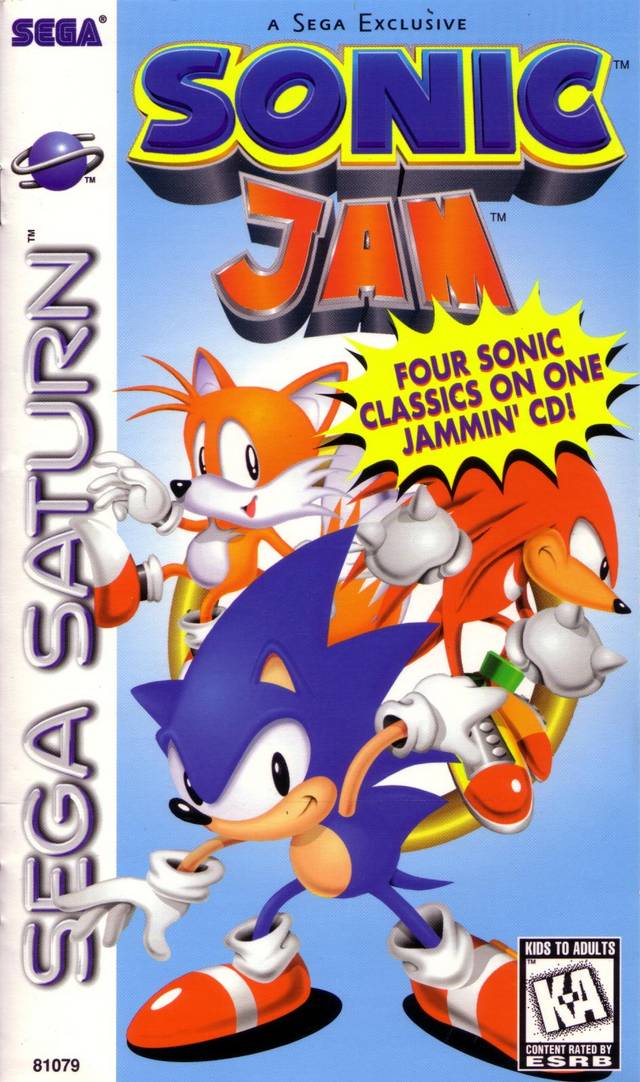 | Sonic Jam | Sega Saturn | Released alongside other Sonic Sega Mega Drive games in 1997. |
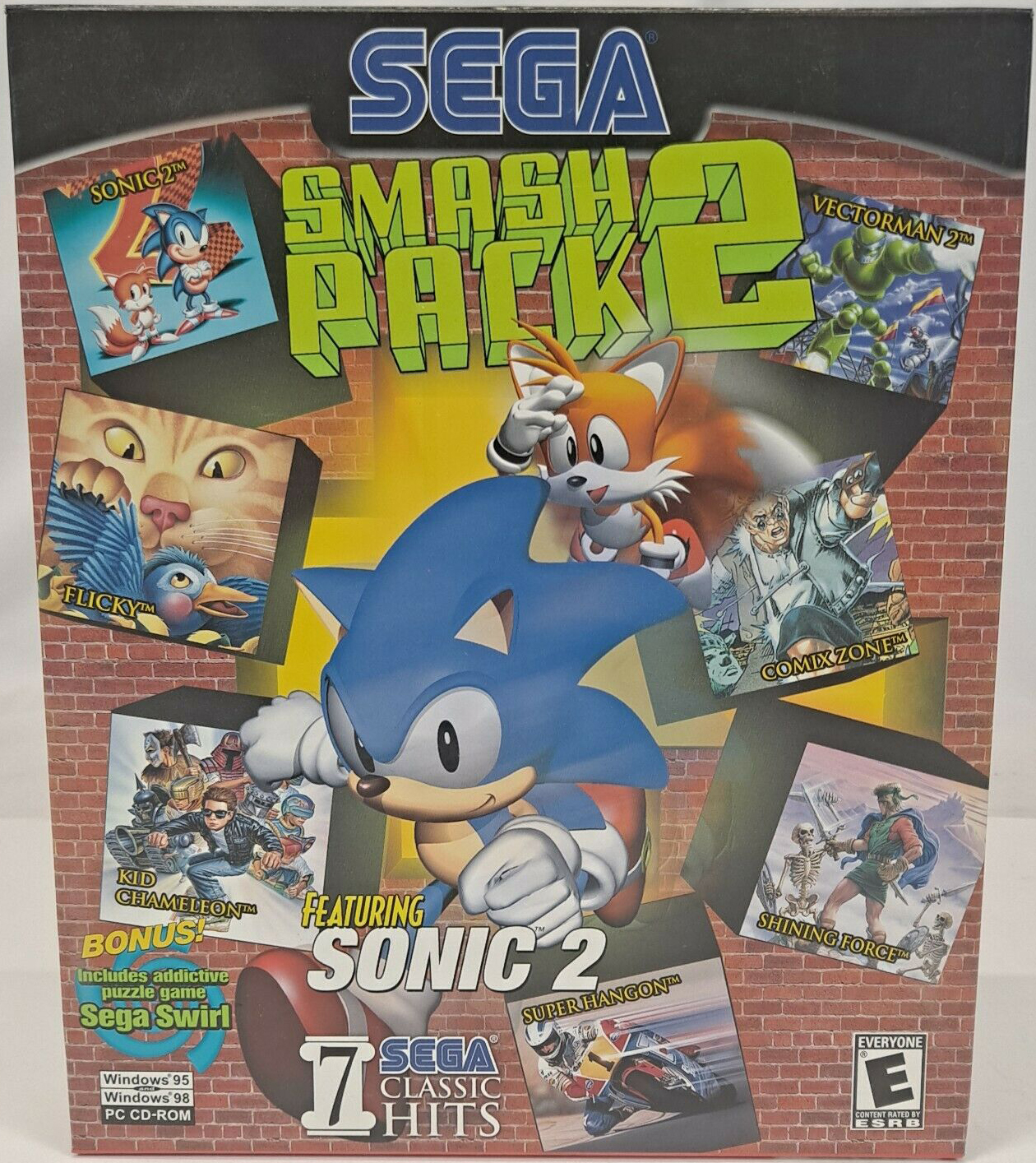 | Sega Smash Pack 2 | PC | Released alongside other Sega Mega Drive games in 2000. |
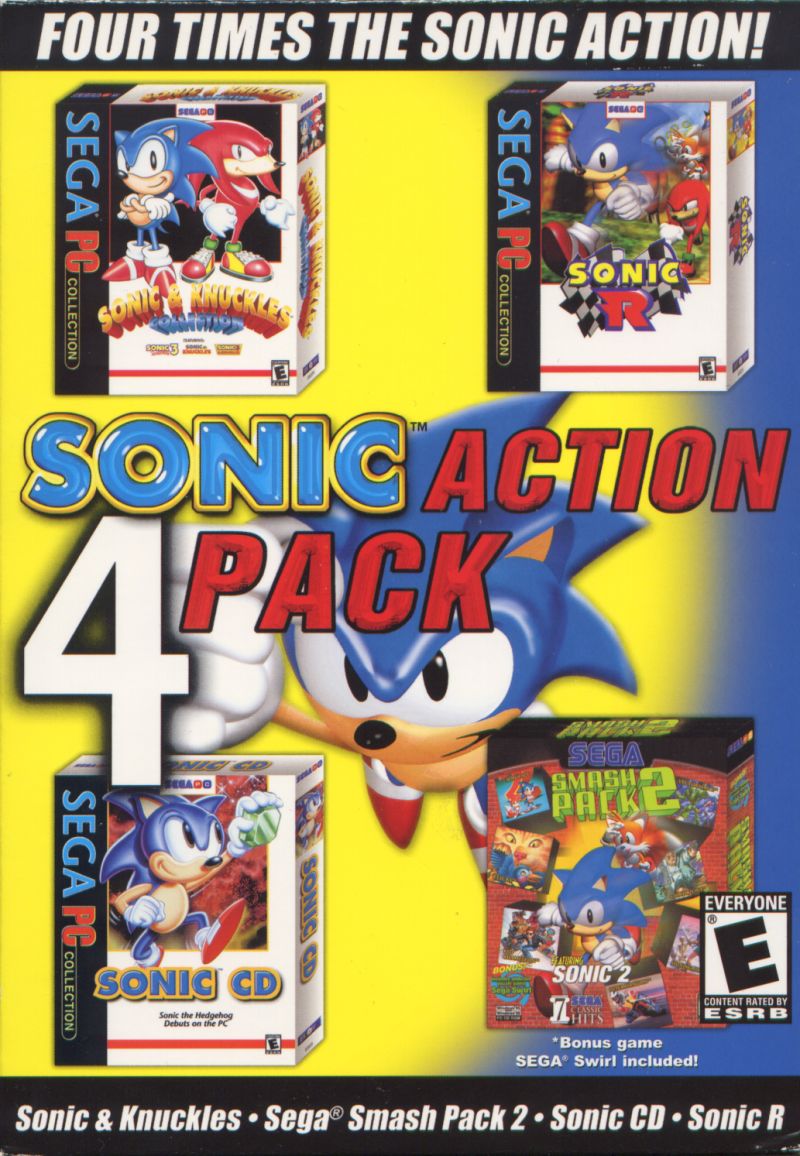 | Sonic Action 4 Pack | Released as part of Sega Smash Pack 2, alongside Sonic the Hedgehog CD, Sonic & Knuckles Collection, and Sonic R; in 2001. | |
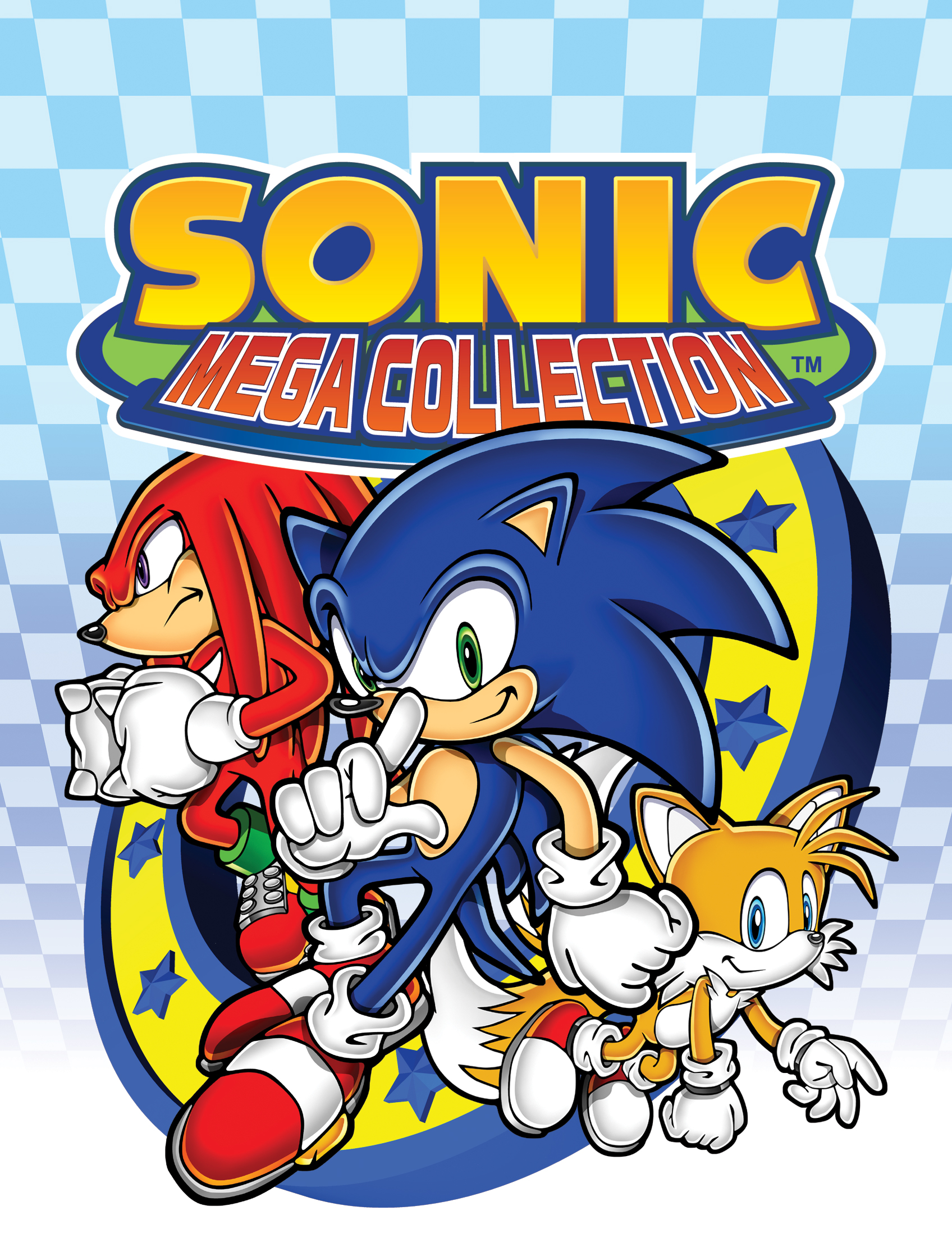 | Sonic Mega Collection | Nintendo GameCube | Released alongside other Sega Mega Drive games in 2002. |
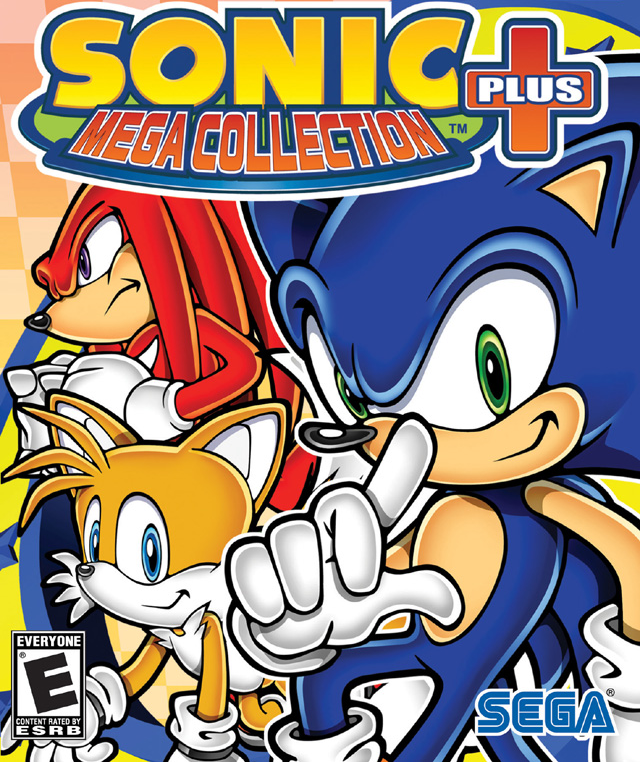 | Sonic Mega Collection Plus | PlayStation 2 Xbox Windows PC | Released alongside other Sega Mega Drive and Game Gear games in 2004. |
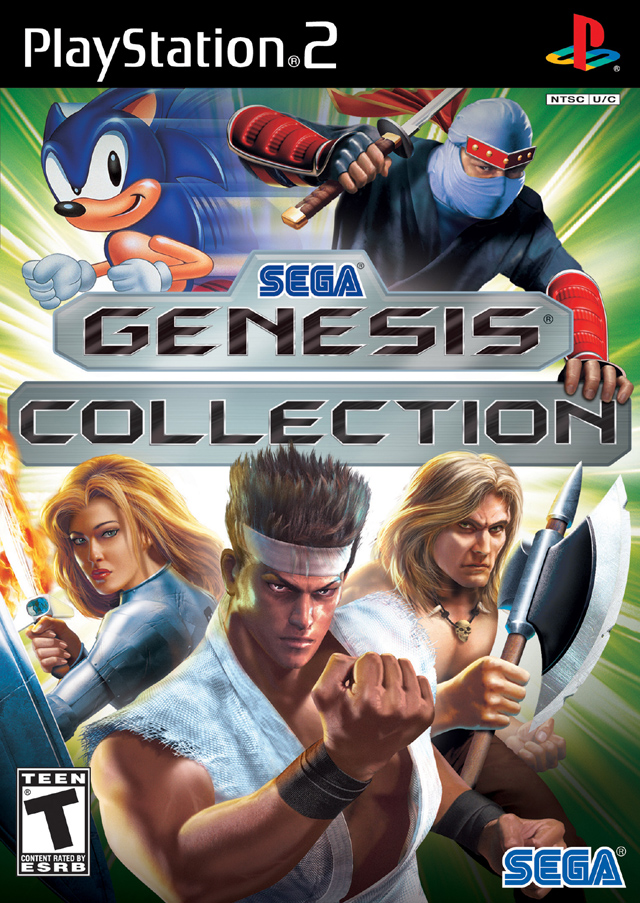 | Sega Genesis Collection | PlayStation 2 PlayStation Portable | Released alongside Sonic the Hedgehog and other Sega Mega Drive games in 2006. |
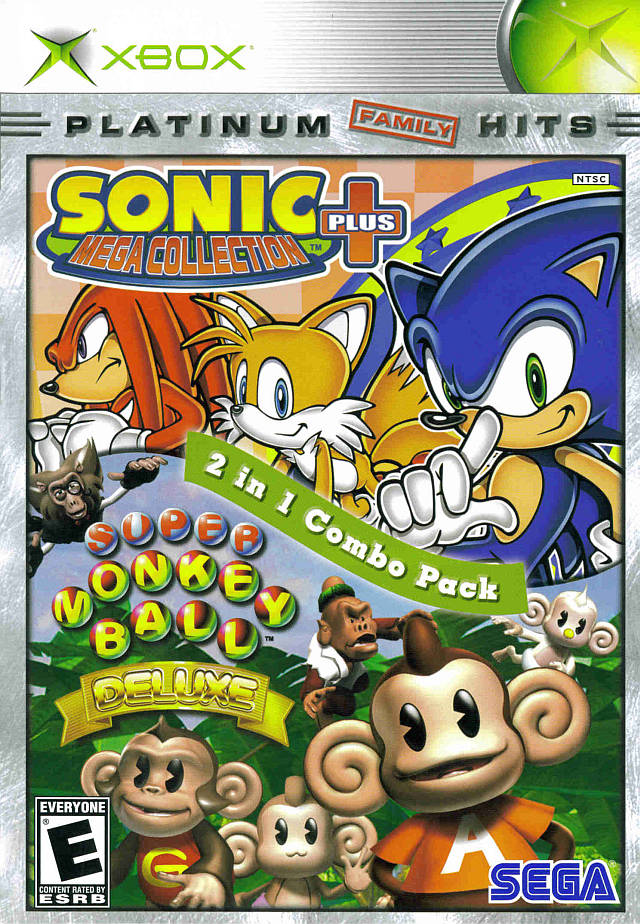 | Sonic Mega Collection Plus / Super Monkey Ball Deluxe 2 in 1 combo pack | Xbox | Released as part of Sonic Mega Collection Plus, alongside Super Monkey Ball Deluxe. |
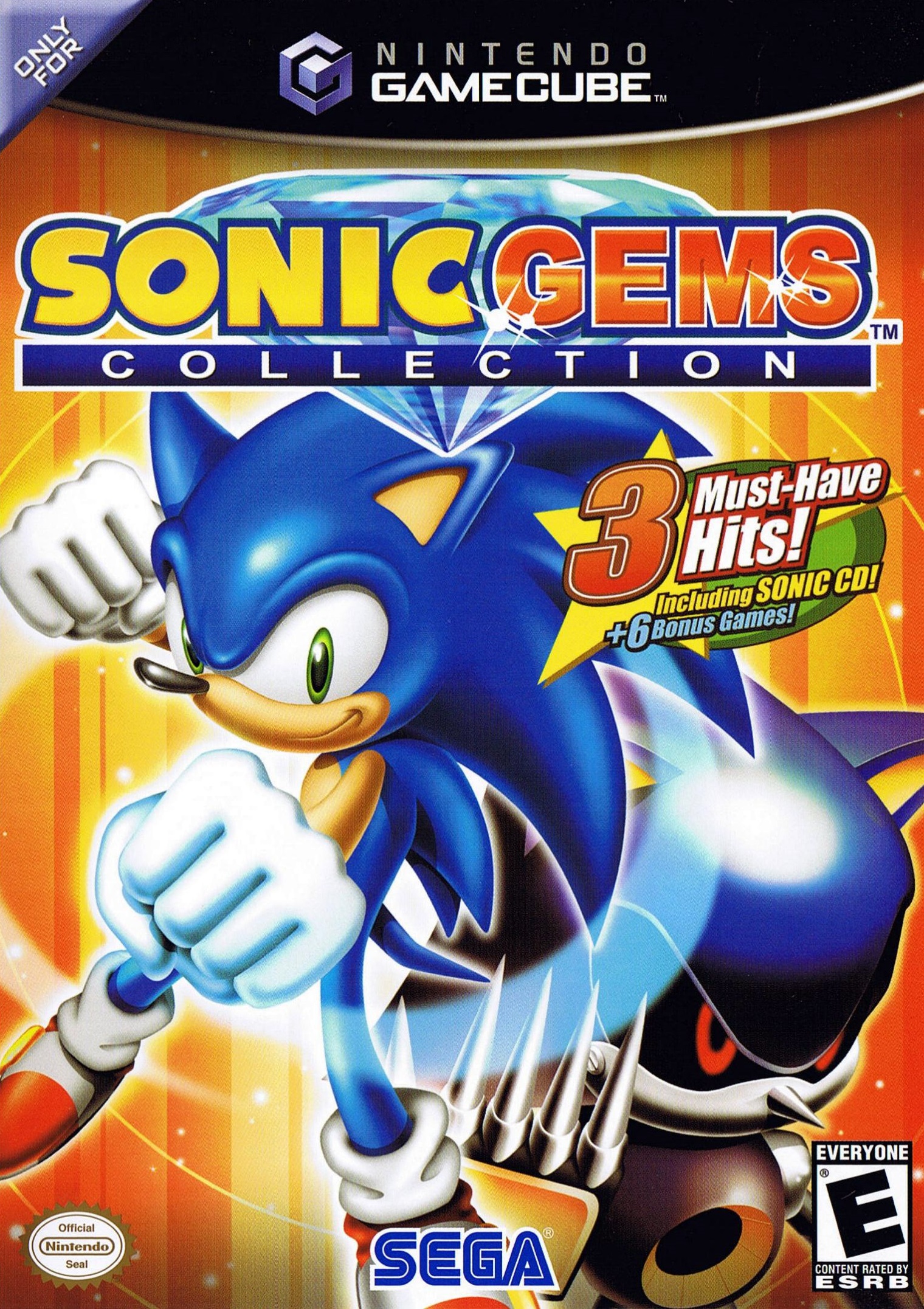 | Sonic Gems Collection | Nintendo GameCube PlayStation 2 | Released as part of the game’s Museum mode in 2005. |
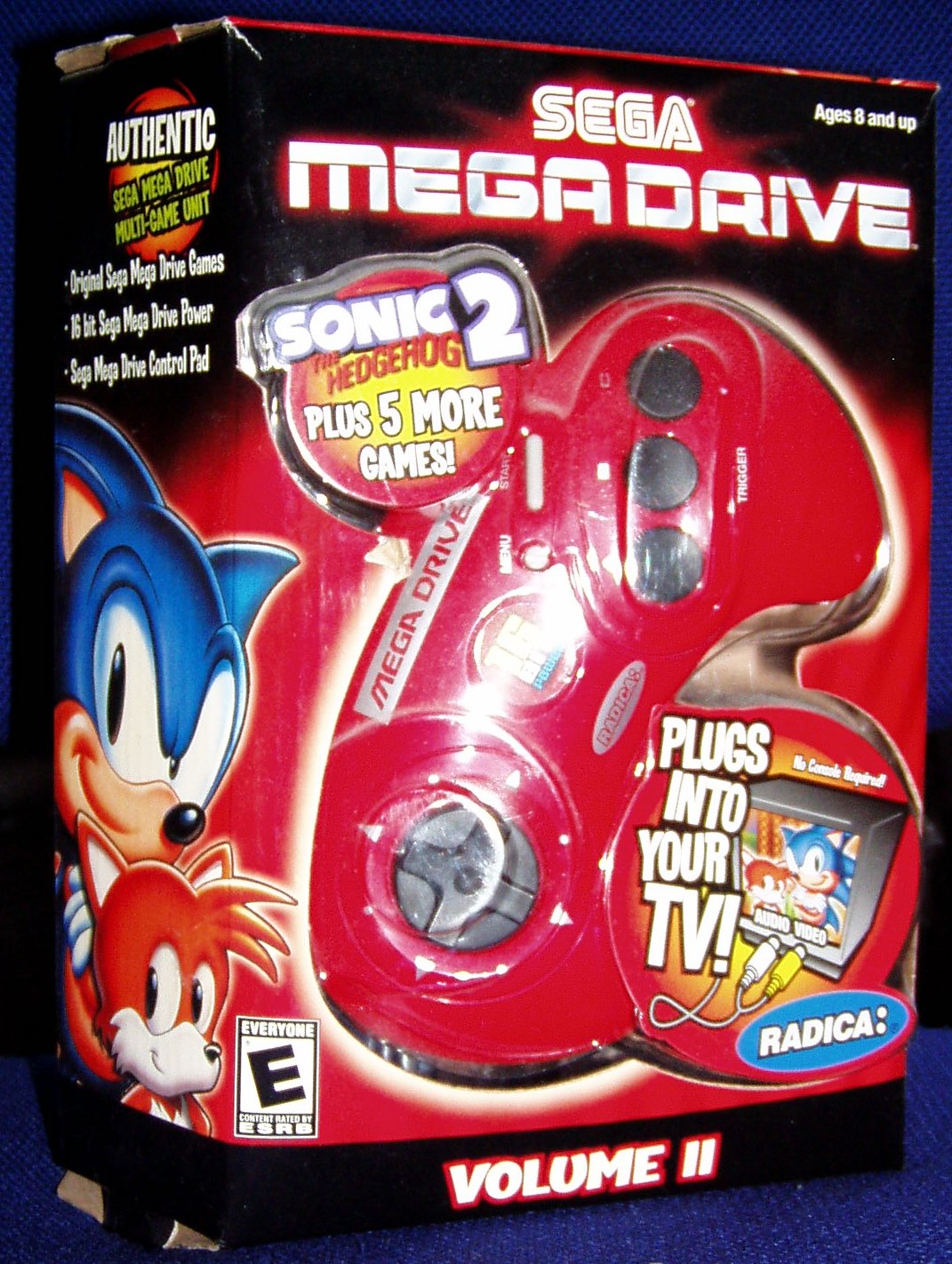 | Sega Mega Drive Collection Vol. 2 | Play TV Legends | Released alongside five other Sega Mega Drive games in 2005. |
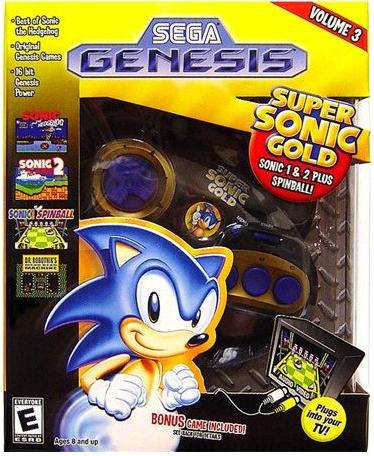 | Super Sonic Gold | Released alongside three other Sega Mega Drive games in 2005. | |
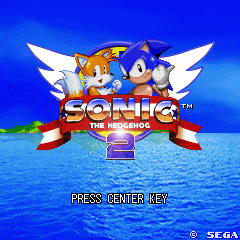 | Sonic the Hedgehog 2 | Mobile | Released as part of the Sonic Cafe service in 2006. |
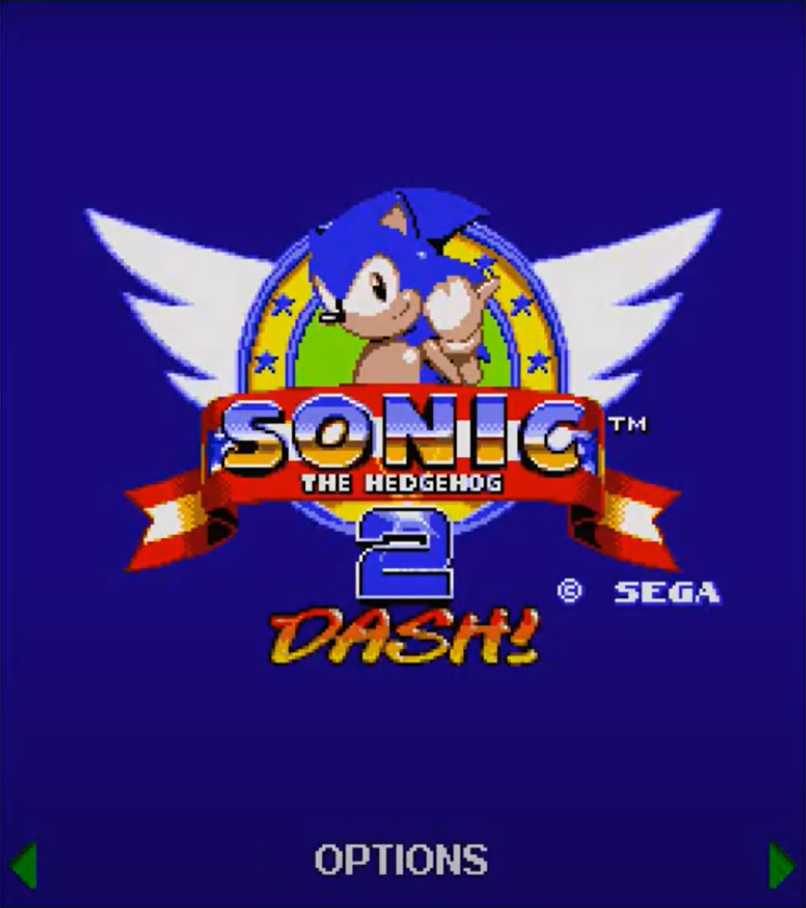 | Sonic the Hedgehog 2: Dash! | J2ME | Re-released for J2ME phones in 2008. |
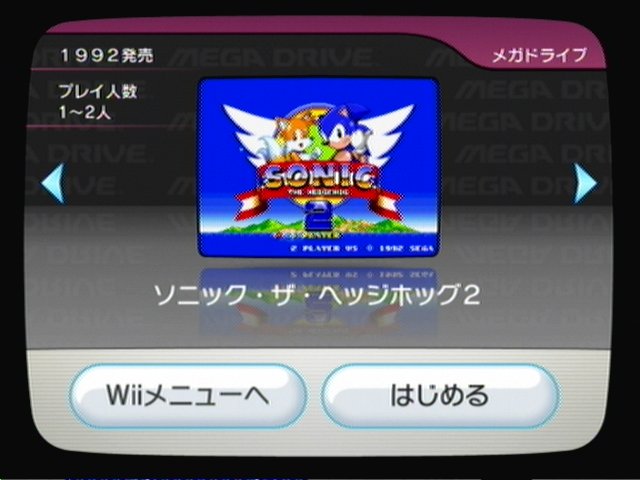 | N/A | Wii | Available for download on the Wii Virtual Console. On 29 October 2015, it was reported that the port would be taken down on 30 October 2015. |
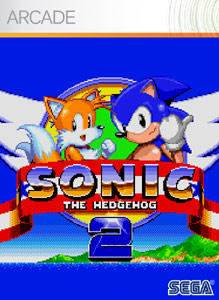 | N/A | Xbox 360 | Re-released as part of the Xbox Live Arcade service. In 20 May 2022, the game has been delisted from the service.[74]Standalone Sonic titles to be delisted May 20th ahead of Sonic Origins release. Delisted Games (20 May 2022). Archived from the original on 2 August 2022. Retrieved on 2 August 2022. |
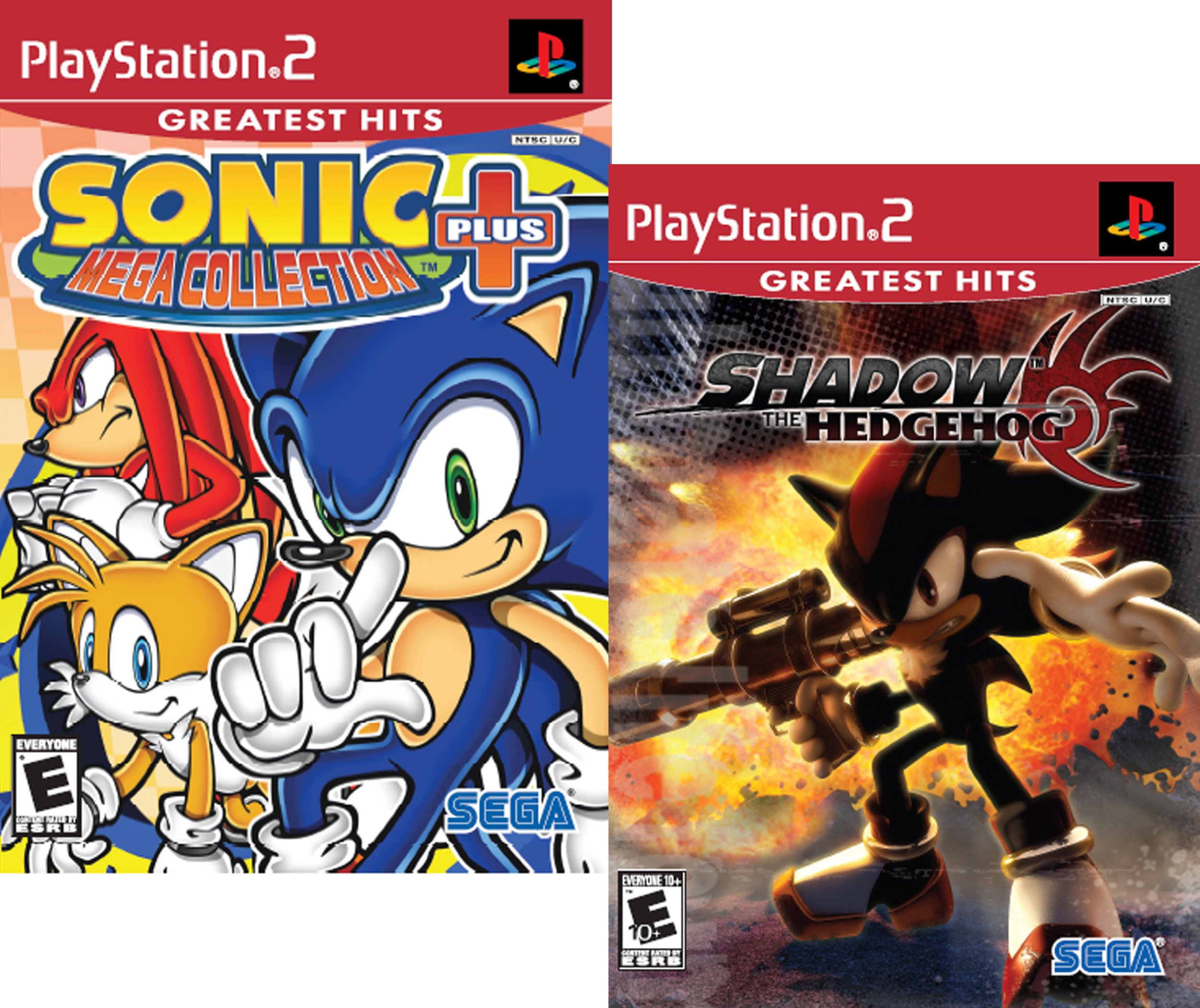 | Sega Fun Pack: Sonic Mega Collection Plus & Shadow the Hedgehog | PlayStation 2 | Released as part of Sonic Mega Collection Plus, alongside Shadow the Hedgehog, in 2009. |
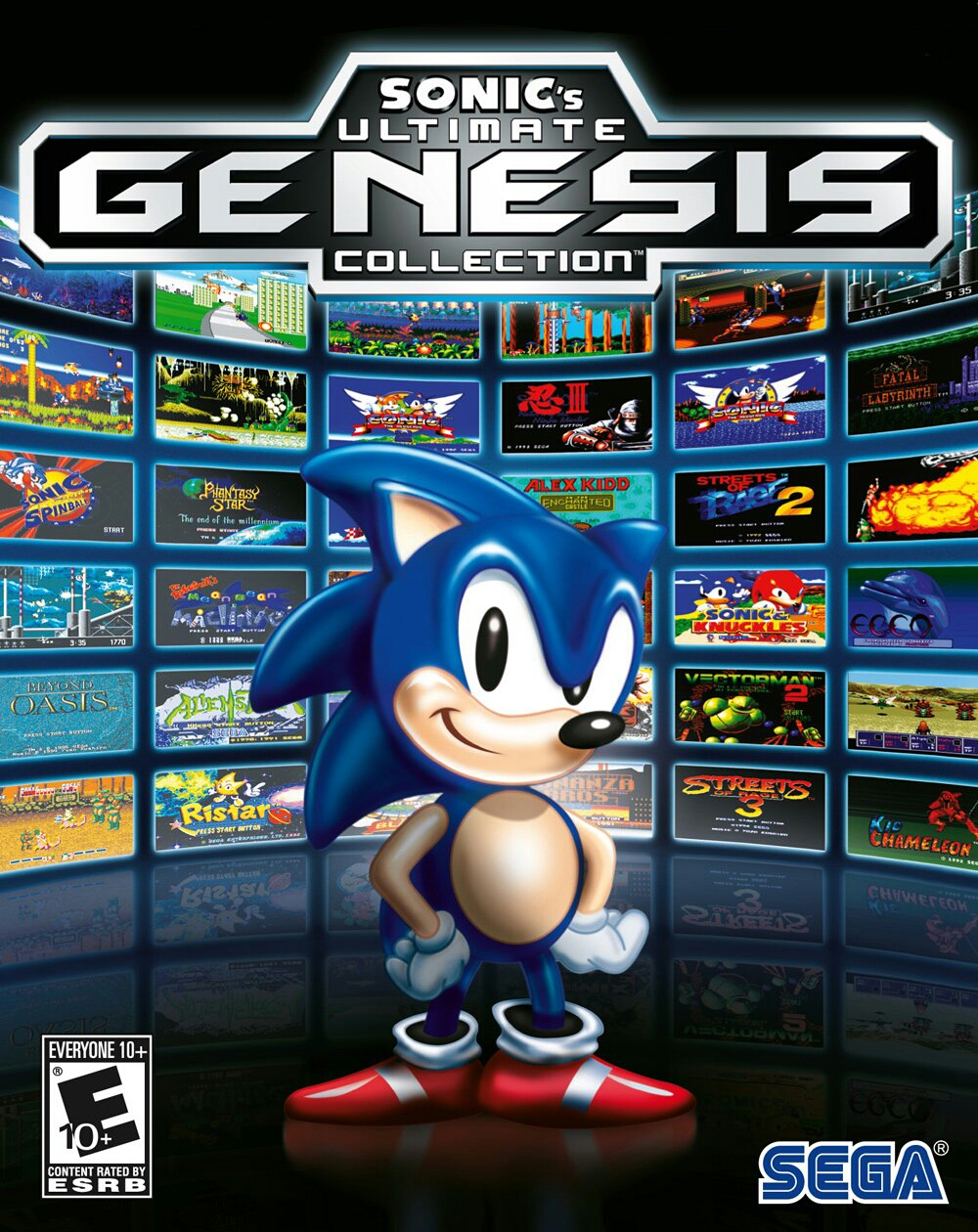 | Sonic’s Ultimate Genesis Collection | PlayStation 3 Xbox 360 | Released alongside other Sega Mega Drive and Game Gear games in 2009. |
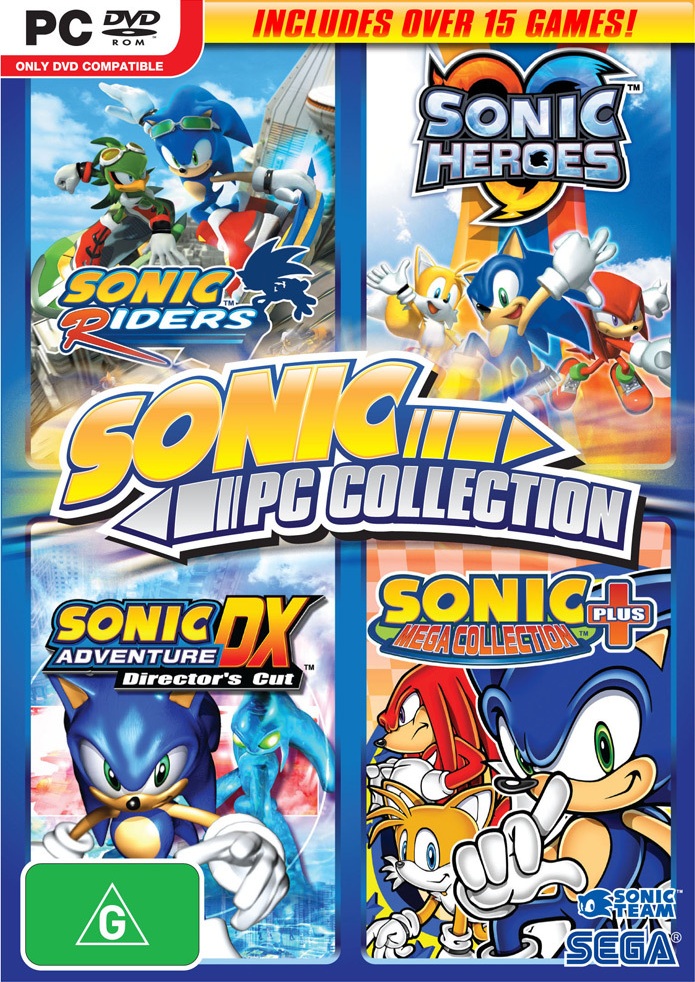 | Sonic PC Collection | PC | Released as part of Sonic Mega Collection Plus, alongside Sonic Riders, Sonic Heroes and Sonic Adventure DX: Director’s Cut; in 2009. |
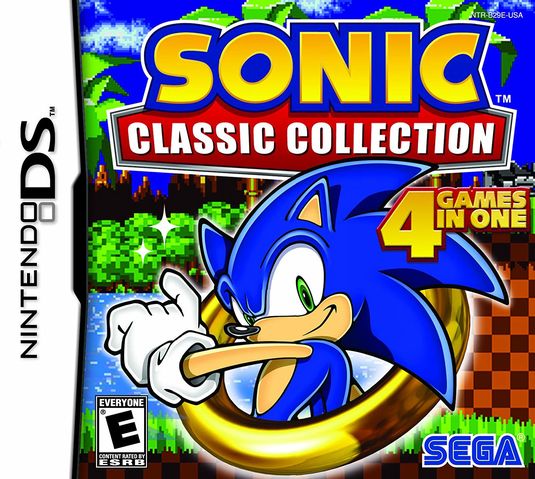 | Sonic Classic Collection | Nintendo DS | Released alongside other Sonic Sega Mega Drive games in 2010. |
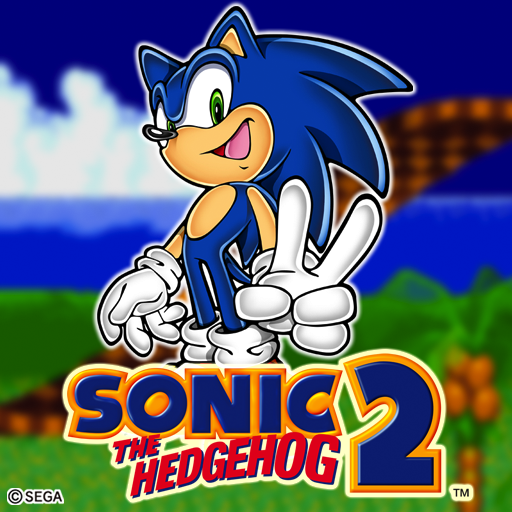 | N/A | iPhone | Released on iPhone devices in 2010. |
 | Browser | Released in 2010 alongside other Sega console games as part of the PlaySega website. | |
| Sonic the Hedgehog 2 | Mobile | Released in 2013. | |
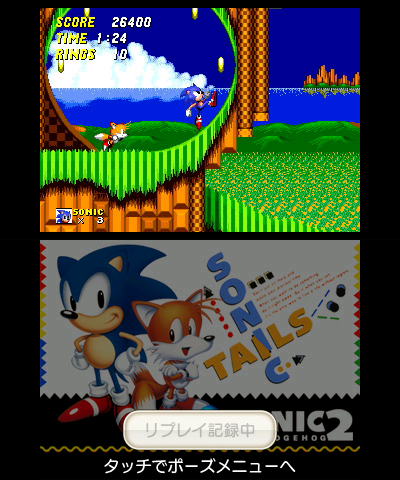 | 3D Sonic the Hedgehog 2 | Nintendo 3DS | Released in 2015. |
| Sega Ages: Sonic the Hedgehog 2 | Nintendo Switch | Re-released on Nintendo Switch as part of the Sega Ages line. Essentially the same as the Nintendo 3DS release sans the 3D feature, but now with Knuckles in Sonic 2. | |
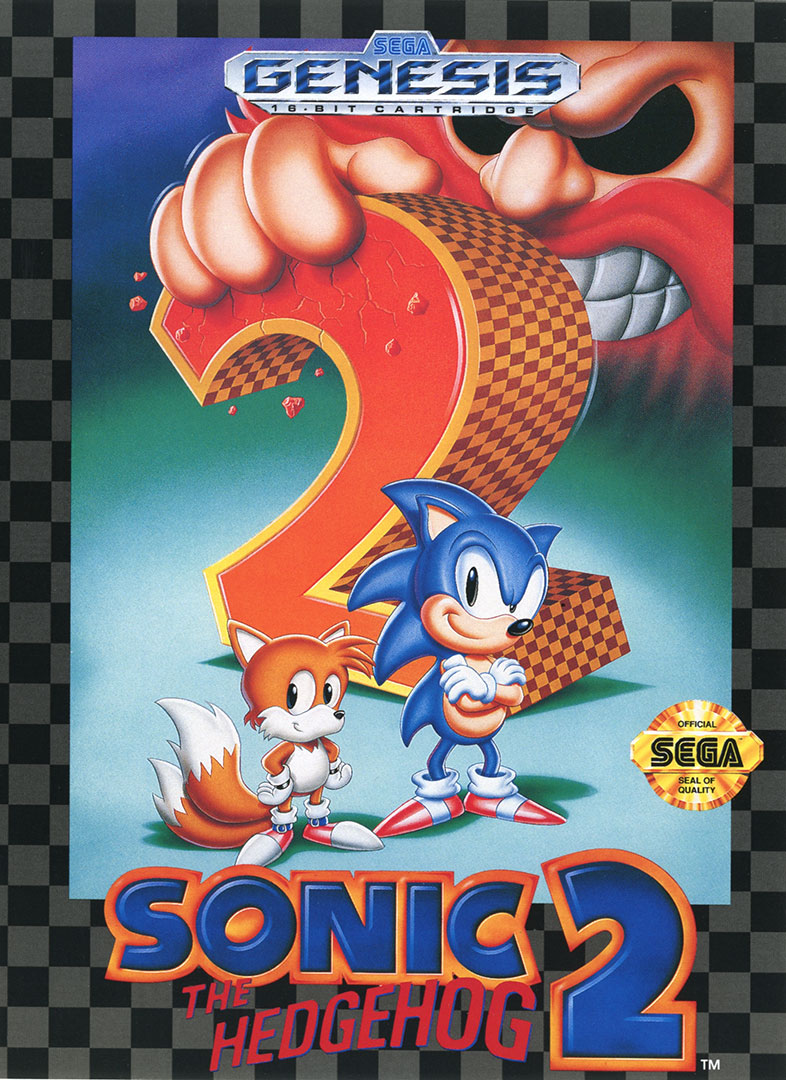 | N/A | Available for download on the Nintendo Switch Online + Expansion Pack service. | |
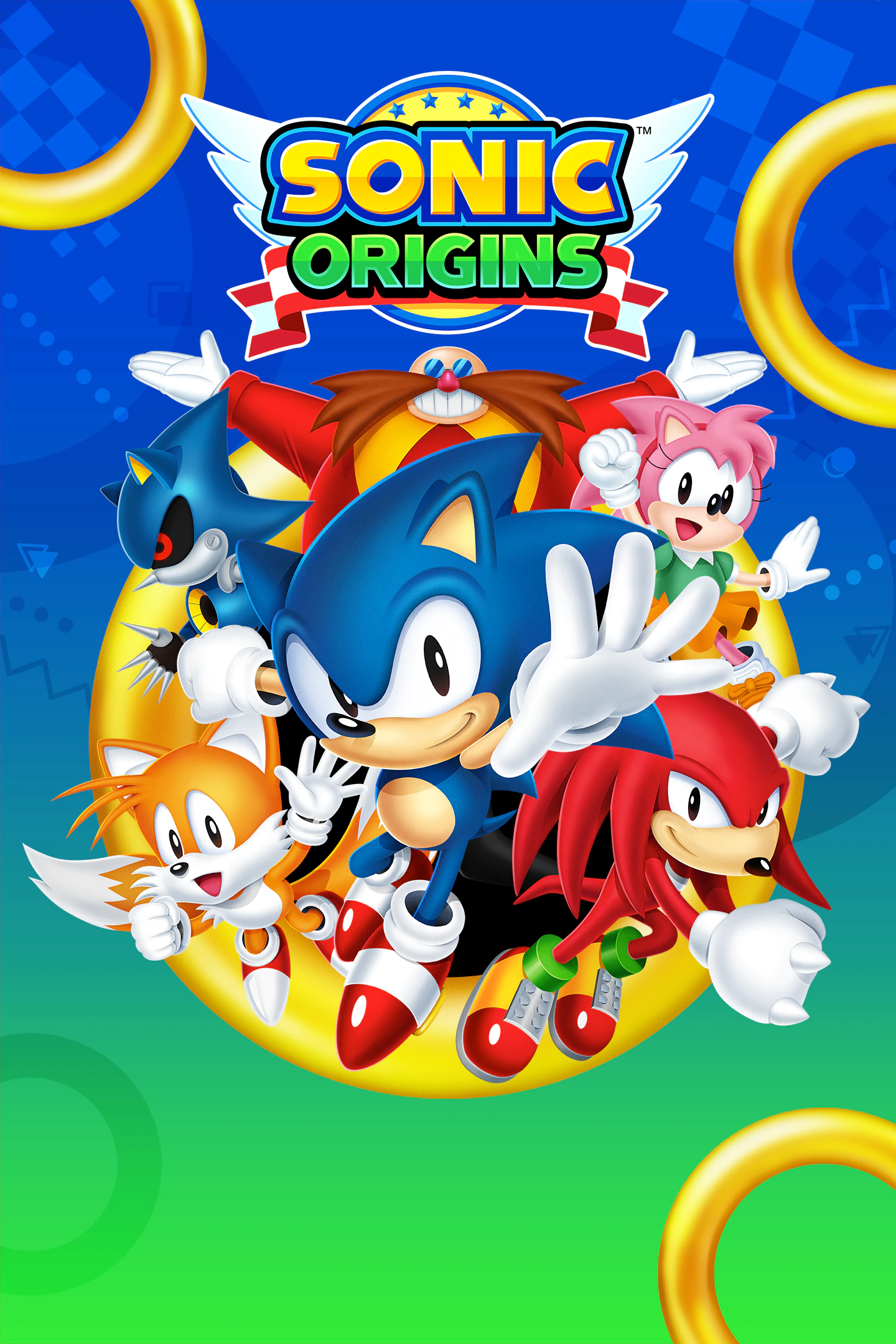 | Sonic Origins | Xbox Series X and Series S Xbox One PlayStation 5 PlayStation 4 Nintendo Switch PC (Steam, Epic Games) | Launched on June 23, 2022, as part of the festivities commemorating the 30th anniversary of the Sonic series, this release encompasses a remastered edition of Sonic the Hedgehog 2. Beyond the original game, this compilation introduces supplementary modes, fresh cinematic sequences, and Mission challenges. Notably, players can now assume the roles of Sonic, Tails, and Knuckles as playable characters, each with their unique abilities. Furthermore, new Zones have been integrated into both the main game and the 2 Player VS mode, augmenting the gameplay experience. Additionally, Sonic’s repertoire of moves now includes the Drop Dash maneuver. |
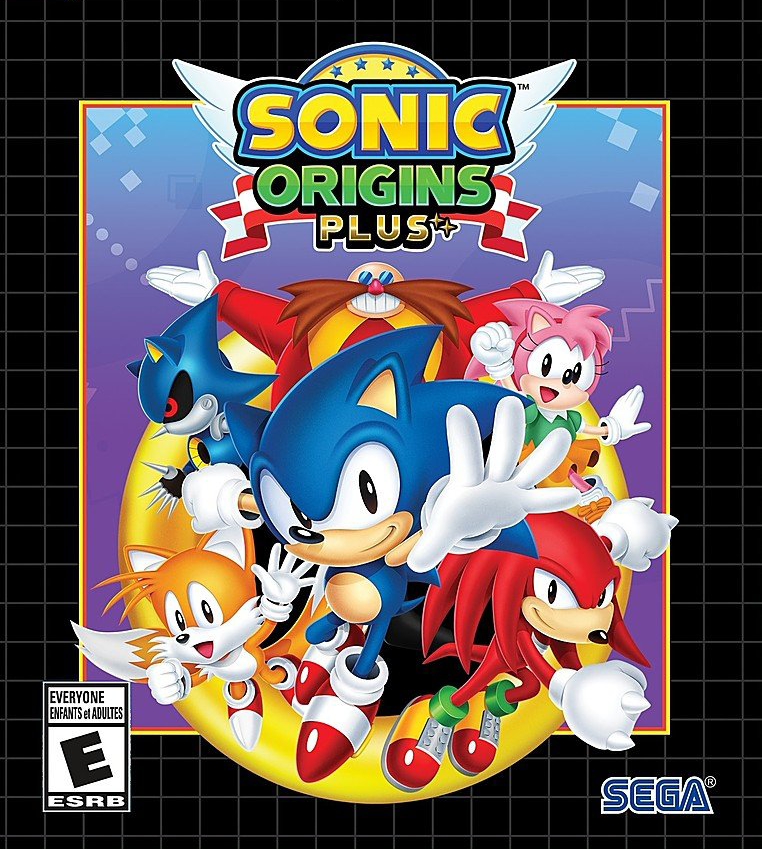 | Sonic Origins Plus | Sonic Origins Plus represents an enhanced and extended edition of the Sonic Origins compilation. Notably, this version introduces Amy Rose as a playable character, broadening the roster of available options. Moreover, all of the Sonic Game Gear titles are included in this release, further enriching the gaming experience. Sonic Origins Plus made its debut on June 23, 2023, precisely one year after the initial version’s launch. A distinctive feature of this iteration is its availability in both physical and digital formats, offering players more ways to enjoy the content. |
Cheat Codes
- Change Tails’ Name to Miles (or Vice Versa):
- At the title screen, input the following sequence: Up, Up, Up, Down, Down, Down, Up.
- This will change Tails’ name to Miles. To revert back to Tails, enter the code again.
- Act Select:
- Access the Options menu and go to the Sound Test.
- Play the following tunes in order: 19, 65, 09, and 17. You will hear the Ring sound.
- Press Start to return to the intro/title screen.
- While on the title screen, press Start while holding
 to enter Act Select.
to enter Act Select. - During gameplay, pause the game and press A to return to the Act Select.
- 14 Continues:
- Go to the Options menu and access the Sound Test.
- Play the following tunes in order: 01, 01, 02, and 04.
- Select the Player Select option to start the game with 14 continues.
- Note that this may overwrite the sound test options with Oil Ocean Zone music.
- Debug Mode:
- Access the Act Select screen from the Sound Test in the Options menu.
- Play the following tunes in order: 01, 09, 09, 02, 01, 01, 02, and 04.
- You will hear a Ring chime, indicating that Debug Mode is now active.
- Highlight any Act and press Start while holding
 to enter Debug Mode.
to enter Debug Mode.
- Obtain All 7 Chaos Emeralds:
- From the Act Select Sound Test, play the following tunes in order: 04, 01, 02, and 06.
- This will play Chaos Emerald music and grant you all seven Chaos Emeralds.
Achievements
Here are the achievements and trophies that can be earned in the Xbox 360 and PlayStation 3 editions of Sonic the Hedgehog 2:
Adaptations
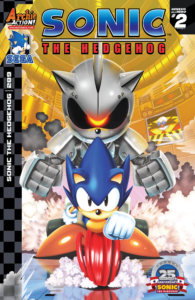
Shogakukan created an adapted version of Sonic the Hedgehog 2 for the Sonic the Hedgehog manga, incorporating a few differences such as the inclusion of original characters from the manga.
The events of Sonic the Hedgehog 2 have been incorporated into the Sonic the Comic series by Fleetway Editions, although not directly adapted. The game is referenced in Sonic the Comic #27, “A Tale of Tails,” and the entire comic series continues from the events of Sonic the Hedgehog 2.
Archie Comics also produced an adaptation of Sonic the Hedgehog 2 as part of their “Genesis” storyline, covered in Sonic the Hedgehog #228-#229. It’s acknowledged that the game’s events occur in the Post-Super Genesis Wave timeline. Ultimately, an adaptation of the game within this timeline was presented in Sonic the Hedgehog #289 as the second part of the “Genesis of a Hero” storyline.
Trivia
- To commemorate the 25th and 30th anniversaries of Sonic the Hedgehog 2, Yasushi Yamaguchi shared a drawing of Tails on Twitter, repeating the gesture in both 2022 and 2023.
- Unlike other 2D Sonic games, Sonic the Hedgehog 2 doesn’t display a “Try Again” message upon completing the game without collecting all Chaos Emeralds.
- An interesting animation anomaly can be observed in the second trailer for Sonic the Hedgehog 4: Episode I. In the Sonic the Hedgehog 2 segment of the trailer, Sonic’s running animation resembles that of the Nick Arcade and Simon Wai prototypes, deviating from the final version.
- In non-Asian versions of the game cover, Dr. Robotnik’s signature blue glasses appear as empty black eyes, potentially influencing how the character was portrayed with black and red eyes in older Sonic media. The cover also features a notably large beard absent in the actual game.
- Sonic the Hedgehog 2 introduced the concept of collecting all seven Chaos Emeralds, marking the debut of the super transformation. This installment also introduced Super Sonic alongside Tails.
- Curiously, the initial iPhone version of Sonic the Hedgehog 2 used recycled artwork from Sonic Advance 2 for its app icon.
- The North American instruction manual of Sonic the Hedgehog 2 features screenshots from early prototypes. For instance, the screenshot of the title screen is from the Beta 4 prototype, while the screenshot of the Oil Ocean Zone displays a different background from the final version.
- Interestingly, the sprite used for the Super and Extended Super achievements in the game is actually a fan-made Sonic Battle sprite found in a sprite sheet created by JoeTE.
Archive Links





References
- ↑ Virtual Console, page 3. Nintendo. Archived from the original on 6 March 2013.
- ↑ Sonic the Hedgehog 2. Nintendo. Archived from the original on 23 November 2010.
- ↑ Sonic the Hedgehog™ 2. Nintendo.
- ↑ Sonic the Hedgehog 2. GameRankings. Archived from the original on 7 March 2014. Retrieved on 3 February 2012.
- ↑ Sonic the Hedgehog 2: What Did the Critics Say in 1993?. Defunct Games.
- ↑ “Sonic the Hedgehog 2“. Computer and Video Games (132). Archived from the original.
- ↑ Electronic Games (3): 72-74. December 1992. Archived from the original.
- ↑ “1998 Video Game Buyer’s Guide”. Electronic Gaming Monthly: 87.
- ↑ Sonic the Hedgehog 2. GameRankings. Archived from the original on 7 March 2014. Retrieved on 3 February 2012.
- ↑ ソニック・ザ・ヘッジホッグ2 (Japanese). Retrieved on 29 December 2014.
- ↑ GameFan (2): 9, 14-17. December 1992.
- ↑ Game Informer (8): 56-57. January/February 1993.
- ↑ “Classic Reviews: Sonic the Hedgehog 2”. Game Informer (109): 104. May 2002.
- ↑ Provo, Frank (2007). Sonic the Hedgehog 2 Review. GameSpot. Retrieved on 21 October 2007.
- ↑ “Review: Sonic the Hedgehog 2“. Mean Machines Sega (2): 60–63. November 1992. Archived from the original. Retrieved on 3 February 2012.
- ↑ “Game Review: Sonic the Hedgehog 2“. Mega (Future Publishing) (2): 36–41. November 1992. Archived from the original. Retrieved on 3 February 2012.
- ↑ “Sonic 2“. MegaTech (EMAP) (11): 3-15. Archived from the original.
- ↑ “Sonic the Hedgehog 2“. Mega Zone (25): 31–33. January 1993. Archived from the original.
- ↑ East, Tom (11 January 2008). Sonic The Hedgehog 2: The blue hedgehog returns. Official Nintendo Magazine. Archived from the original on 31 October 2013. Retrieved on 3 February 2012.
- ↑ “Reviewed: Sonic the Hedgehog 2 (Mega Drive)“. Sega Force (Impact Magazines) (12): 14–16. December 1992. Archived from the original. Retrieved on 3 February 2012.
- ↑ “Sonic the Hedgehog 2“. Sega Pro (15): 52-59. Christmas 1992. Archived from the original.
- ↑ Bad Influence! (2): 46-47. 1993. Archived from the original.
- ↑ Turner, Dyson (17 July 2004). Sonic The Hedgehog 2. Sega-16. Retrieved on 28 February 2022.
- ↑ “Sonic 2”. Sega Force Mega (Impact Magazines) 2 (1): 91. August 1993.
- ↑ Svenska Hemdatornytt (1): 37. January 1993. Archived from the original.
- ↑ “Buyer’s Guide: Best Game of the Year (Genesis)”. Electronic Gaming Monthly. 1993. “Sega’s famous mascot — Sonic the Hedgehog is back for his second visit to the Genesis, and this version is hot! With 8 megabits of memory good ol’ Sonic has a lot more room to do cool tricks and this is what makes this version stand head and shoulders above all the other Genesis games that came out this year. All in all, Sonic 2 is the best Genesis cart to come along in a long time!”
- ↑ Game Informer (8): 34. January/February 1993.
- ↑ Virtual Console Mondays: June 11, 2007. Nintendo World Report. Retrieved on 21 October 2007.
- ↑ Sonic the Hedgehog 2 on Xbox LIVE Arcade. Xbox. Microsoft. Retrieved on 21 October 2007.
- ↑ Sonic the Hedgehog 2 (Sega Mega Drive) Japanese instruction booklet, pgs. 4-5.
- ↑ Sonic the Hedgehog 4: Episode I. Story. Sega. Archived from the original on 12 May 2013. Retrieved on 27 October 2017.
- ↑ (in Japanese) ソニックジャム オフィシャルガイド. SoftBank. 2 October 1997. p. 53. ISBN 978-4797303377.
- ↑ Sonic the Hedgehog 2 (Sega Mega Drive) Japanese instruction booklet, pg. 43.
- ↑ Sonic the Hedgehog 2 (Sega Mega Drive) Japanese instruction booklet, pgs. 44-45.
- ↑ Sonic the Hedgehog 2 (Sega Genesis) United States instruction booklet, pgs. 5–6.
- ↑ Horowitz, Ken . Developer’s Den: Sega Technical Institute. Sega-16. Archived from the original on 16 August 2011. Retrieved on 27 March 2023.
- ↑ Maba, Ray (24 June 2016). 『ソニック・ザ・ヘッジホッグ』誕生・ヒット・新生の真実をソニックチームのレジェンドクリエイターが、25周年のいま明かす 秘蔵資料満載の永久保存版! (Japanese). Famitsu. Retrieved on 27 March 2023.
- ↑ Maba, Ray (24 June 2016). 『ソニック・ザ・ヘッジホッグ』誕生・ヒット・新生の真実をソニックチームのレジェンドクリエイターが、25周年のいま明かす 秘蔵資料満載の永久保存版! (Japanese). Famitsu. Retrieved on 27 March 2023.
- ↑ strafefox (22 May 2018). The Making of Sonic the Hedgehog 2. YouTube. Retrieved on 20 April 2023.
- ↑ Shea, Brian (21 November 2017). The Behind-The-Scenes Story Of How Sonic 2 Became Sega’s Ace In The Hole. Game Informer. Retrieved on 27 March 2023.
- ↑ Video Archive (22 April 2022). Sonic Panic (Sonic 2 Promo Video) [ENGLISH CC] {Windii Reupload}. YouTube. Retrieved on 27 March 2023.
- ↑ Judy Totoya on Twitter. Twitter (21 November 2022). Retrieved on 21 November 2022.
- ↑ Sonic’s Creator – Yuji Naka. Archived from the original on 5 June 1997. Retrieved on 28 August 2008.
- ↑ Al Nilsen on Twitter. Twitter (29 December 2021). Archived from the original on 29 December 2021. Retrieved on 29 December 2021..
- ↑ Sega’s Yuji Naka Talks!. GameSpy. Retrieved on 3 January 2015. “GameSpy: Was the Hidden Palace meant to be “hidden,” then? / Yuji Naka: You’d encounter the stage through normal play by collecting the emeralds. The idea behind the stage was, ‘Where do the Chaos Emeralds come from?’ That’s where Sonic was originally supposed to be granted his Super Sonic powers. We finally were able to use it in S&K, though it wound up being quite different from what we had planned in Sonic 2. But even from Sonic 1 we’d been throwing around those sorts of ideas. Still, when we were running out of time, we looked over things quickly trying to figure out what to dump … and CHOP went the Hidden Palace. There’s simply no way we could have thrown that in by the deadline at the rate we were going.”
- ↑ Craig Stitt Interview. Sonic Research Zone (23 January 2001). Retrieved on 25 January 2015.
- ↑ “The People Making Sega’s Future“. Beep! Mega Drive (SoftBank): 46–48. January 1993. Archived from the original on 29 December 2021.. “Yuji Naka: There’s still so much I want to add. For Sonic 2, we had to remove so much due to memory limitations. We actually made about five more zones, but in the end, we had to cut them all. We actually cut one zone at the absolute very last minute. Even though it was basically complete, we couldn’t use it because of a lack of memory. There just wasn’t enough space.”
- ↑ Kemps, Heidi (15 July 2020). 7 Sonic The Hedgehog Prototypes You Were Never Meant To Play. Kotaku. Retrieved on 19 April 2023.
- ↑ Ayden_ (3 April 2022). L’histoire des boitiers et jaquettes du jeu vidéo : Artistes, mystères et anecdotes (French). Jeuxvideo.com. Retrieved on 19 April 2023.
- ↑ Bryant, Martin (25 July 2015). Sonic 2 and making a real impact with your marketing. The Next Web. Retrieved on 19 April 2023.
- ↑ Sonic the Hedgehog (24 November 2022). Sonic the Hedgehog on Twitter. Twitter. Retrieved on 19 April 2023. “It’s been 30 years since Sonic 2sday and the release of Sonic the Hedgehog 2. Life wouldn’t be the same without you, little buddy!”
- ↑ Lucas M., Thomas (2007). IGN’s Sonic the Hedgehog 2 Review. IGN. Ziff Davis. Retrieved on 21 October 2007.
- ↑ “Official Gallup UK Mega Drive Sales Chart”. Mega (6). March 1993.
- ↑ Shea, Brian (July 20 2022). Sonic Frontiers Cover Story – Brave New World. Game Informer. Retrieved on 23 July 2022.
- ↑ Boutros, Daniel (4 August 2006). A Detailed Cross-Examination of Yesterday and Today’s Best-Selling Platform Games. Gamasutra. Retrieved on 8 December 2006.
- ↑ Kai, Norton (April 1993). “Sonic CD Slips Up“. Sega Force (16): 12. Archived from the original. Retrieved on 28 February 2022.
- ↑ “Game Zero’s Sonic the Hedgehog 2 Review“. Game Zero. 1993. Archived from the original.
- ↑ Thomas, Lucas M. (26 January 2007). Sonic the Hedgehog VC Review. IGN. Retrieved on 18 November 2014.
- ↑ Dotson, Carter . Sonic the Hedgehog 2 Gets the Remastering Treatment, With the Long-Lost Hidden Palace Level Restored. 148Apps. Retrieved on 18 November 2014.
- ↑ Thomas, Lucas M. (11 June 2007). Sonic the Hedgehog 2 Review. IGN. Retrieved on 18 November 2014.
- ↑ Burrill, William (12 December 1992). “This Sonic is super, too”. Toronto Star: F4.
- ↑ “Top 100 Games of All Time”. Game Informer (100): 28. August 2001.
- ↑ Game Informer’s Top 200 Games of All Time. Game Informer (2009).
- ↑ Mega (Future Publishing) (26): 74. November 1994.
- ↑ EGM Top 100. Electronic Gaming Monthly (November 1997). Retrieved on 1 June 2011.
- ↑ Spring 2004: Best. Game. Ever.. Retrieved on 16 July 2008.
- ↑ Top 100 greatest video games ever made. GamingBolt (2013).
- ↑ Guinness World Records 2009 Gamer’s Edition reveals the Top 50 console games of all time. Guinness World Records Gamer’s Edition (2009).
- ↑ NowGamer (Imagine Publishing). 2010. part 1, part 2, part 3, part 4
- ↑ Retro Gamer (1): 30. January 2004.
- ↑ The 100 greatest computer games of all time. Yahoo! (2006).
- ↑ IGN Staff (15 July 2022). The 10 Best Sonic Games. IGN. Retrieved on 2 December 2022.
- ↑ Reynolds, J. (2022) Top 20 Best Sonic The Hedgehog Games, WatchMojo. Available at: https://watchmojo.com/video/id/48699 (Accessed: December 19, 2022).
- ↑ Standalone Sonic titles to be delisted May 20th ahead of Sonic Origins release. Delisted Games (20 May 2022). Archived from the original on 2 August 2022. Retrieved on 2 August 2022.
External Links
- Sonic the Hedgehog 2 at Secrets of Sonic Team
- Sonic the Hedgehog 2 at Wikipedia, the free encyclopedia


